语用学级期末深刻复习思考题
应用语言学期末复习各章知识点百题汇总
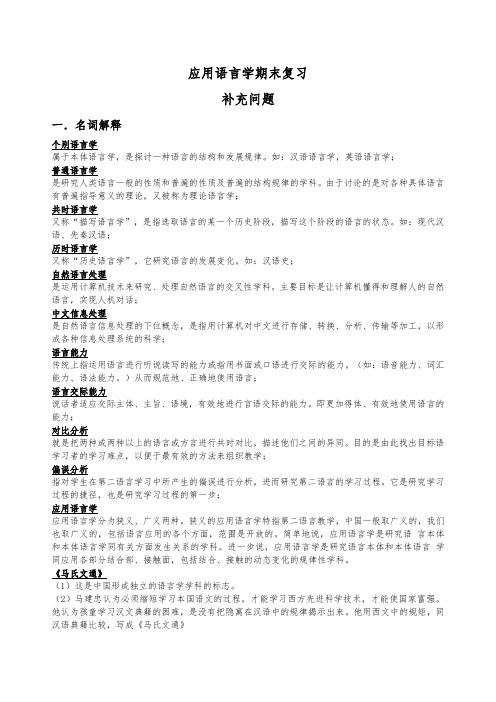
应用语言学期末复习补充问题一.名词解释个别语言学属于本体语言学,是探讨一种语言的结构和发展规律。
如:汉语语言学,英语语言学;普通语言学是研究人类语言一般的性质和普遍的性质及普遍的结构规律的学科。
由于讨论的是对各种具体语言有普遍指导意义的理论,又被称为理论语言学;共时语言学又称“描写语言学”,是指选取语言的某一个历史阶段,描写这个阶段的语言的状态。
如:现代汉语、先秦汉语;历时语言学又称“历史语言学”,它研究语言的发展变化。
如:汉语史;自然语言处理是运用计算机技术来研究、处理自然语言的交叉性学科。
主要目标是让计算机懂得和理解人的自然语言,实现人机对话;中文信息处理是自然语言信息处理的下位概念,是指用计算机对中文进行存储、转换、分析、传输等加工,以形成各种信息处理系统的科学;语言能力传统上指运用语言进行听说读写的能力或指用书面或口语进行交际的能力。
(如:语音能力、词汇能力、语法能力。
)从而规范地、正确地使用语言;语言交际能力说话者适应交际主体、主旨、语境,有效地进行言语交际的能力。
即更加得体、有效地使用语言的能力;对比分析就是把两种或两种以上的语言或方言进行共时对比,描述他们之间的异同。
目的是由此找出目标语学习者的学习难点,以便于最有效的方法来组织教学;偏误分析指对学生在第二语言学习中所产生的偏误进行分析,进而研究第二语言的学习过程。
它是研究学习过程的捷径,也是研究学习过程的第一步;应用语言学应用语言学分为狭义、广义两种。
狭义的应用语言学特指第二语言教学,中国一般取广义的,我们也取广义的,包括语言应用的各个方面,范围是开放的。
简单地说,应用语言学是研究语言本体和本体语言学同有关方面发生关系的学科。
进一步说,应用语言学是研究语言本体和本体语言学同应用各部分结合部、接触面,包括结合、接触的动态变化的规律性学科。
《马氏文通》(1)这是中国形成独立的语言学学科的标志。
(2)马建忠认为必须缩短学习本国语文的过程,才能学习西方先进科学技术,才能使国家富强。
语言学概论复习题(范文)
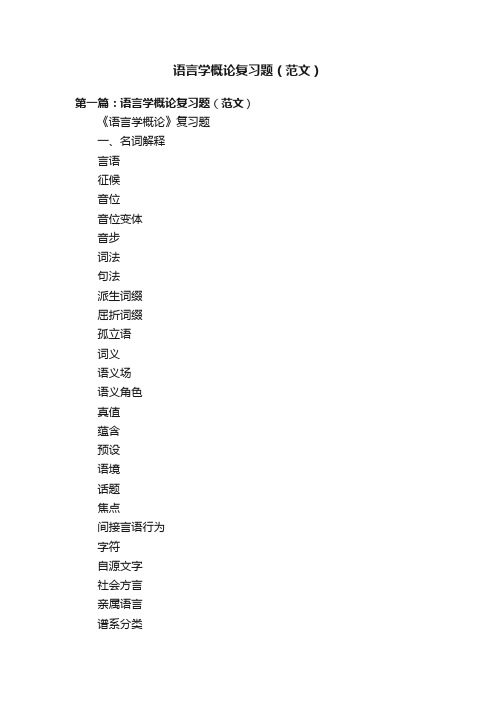
语言学概论复习题(范文)第一篇:语言学概论复习题(范文)《语言学概论》复习题一、名词解释言语征候音位音位变体音步词法句法派生词缀屈折词缀孤立语词义语义场语义角色真值蕴含预设语境话题焦点间接言语行为字符自源文字社会方言亲属语言谱系分类语言联盟语言替换民族共同语克里奥耳语类推二、思考题1、为什么说语言是人类最重要的信息传递的手段?答:除了语言之外,人们还使用其他的信息传递工具:(1)文字、旗语、红绿灯、电报代码、数学符号、化学公式等辅助性的交际工具(2)体态语等伴随性的副语言交际工具,(3)盲文、手语等类语言交际工具。
但这些交际工具或者使用范围的有限,或者运用效率低下,或者使用频率不高,很难与语言这种交际工具相提并论。
文字记录语言,打破了语言交际中时间和空间的限制,在社会生活中起着重大的作用,中小学语文教学主要就是教学生识字、阅读、写作。
但是,文字在交际中的重要性远不能和语言相比。
一个社会可以没有文字,但是不能没有语言;没有语言,社会就不能生存和发展。
文字是在语言的基础上产生的,只有几千年的历史。
在文字产生以前,语言早已存在,估计有几十万年。
今天世界上没有文字的语言比有文字的语言多得多。
文字产生以后要随着语言的发展而演变,它始终从属于语言,是一种辅助的交际工具。
总之,在上述的种种信息传递工具当中,身势等伴随动作是非语言的交际工具;旗语之类是建立在语言,文字基础之上的辅助性交际工具;文字是建立在语言基础之上的一种最重要的辅助交际工具;语言是人类最重要的信息传递工具。
2、为什么说思维离不开语言?答:(1)语言是人类思维的工具,思维活动必须用语言作手段(2)语言是保存思维成果的媒介。
思维成果必须依靠语言的巩固才能得以保持。
(3)语言可帮助思维逐步深化(4)语言可帮助思维条理化(5)语言可帮助传递思维成果。
思维的成果靠语言才能表达出来,使听读者了解。
3、语言符号有何特点?答;(1)语言符号,是对心理现实现象的概括。
(0126)语言学概论复习思考题

(0126)语言学概论复习思考题(0126)《语言学概论》复习思考题一、选择题。
每小题有四个备选答案,选出一个正确答案,并将它的番号填入题干的括号内。
1、[ i ]是一个()①舌尖元音②舌面元音③卷舌元音④舌根元音2、现代汉语属于()①历时语言学②共时语言学③应用语言学④普通语言学3、下面划线部分作为词根的是()①阿姨②作者③儿子④第一4、根据语言的形态分类,汉语属于()①孤立语②屈折语③粘着语④多式综合语5、“他读书”中的“书”和“我看报”中的“报”之间的关系为()①组合关系②聚合关系③线性关系④任意关系6、语言中发展速度最慢的是()①语音②语义③语法④一般词汇7、从造字方法看,兼用表意表音两种方法的文字叫()①表意字②假借字③指事字④意音文字8、英语tooth→teeth采用的语法手段是( )①加词尾②加词缀③变换重音的位置④词根内部音素的变化9、多义词的中心意义与本义()①完全一致②在少数词中是一致的③在多数词中是一致的④完全不一致10、按照普通话及重庆话的读音,“路”、“庞”、“移”等字都没有代表读音的部分,这说明它们()①不是形声字②是形声字③没有表音的成分在内④读音古今变化很大11、以声音的高低来区别意义的语言单位叫①时位②重位③调位④音质音位12、一般说来,新词、古词、方言词、行业词和外来词等①属于一般词汇②属于基本词汇③有的属于基本词汇,有的属于一般词汇④有时属于基本词汇,有时属于一般词汇13、语言符号与它所代表的事物之间()①在意义上有一定的联系②在特征上有一定的联系③在意义和特征上都有一定的联系④在意义和特征上都没有联系14、现代汉语的“着”、“了”、“过”也表示()的语法范畴①体②时③态④人称15、社会方言的特点反映在()方面最明显。
①语音②词汇③语法④行业用语16、鹦鹉可能一口气背出若干首诗,这说明()①鹦鹉有比较低级的语言能力②鹦鹉有一种机械模仿声音的本能③鹦鹉可以就有限的内容跟它的主人交际④鹦鹉具有比其他动物强的语言能力17、音位的条件变体和自由变体()①前者区别意义,后者不区别意义②前者出现的环境是互补的,后者可以出现在同样的环境中③前者不能出现在同样环境中,后者出现的环境是互补的④前者是对立关系,后者是互补关系18、一种语言中的词汇和语法,()①前者是有限的,后者是无限的②前者是无限的,后者是有限的③都是无限的④都是有限的19、词是语言中()①最小的单位②音义结合的最小单位③能够独立运用的最小单位④用于交际的基本表述单位20、世界语(Esperanto)是()①法国人设计的②德国人设计的③波兰人设计的④美国人设计的21、随着语言的发展,印欧语系语言大多由“宾—动”型变成“动—宾”型,这是语法()①词类的发展②组合规则的发展③聚合规则的发展④语法范畴的消长22、下列特征中,普通话辅音音位/t/ 具有的区别特征是()。
(完整版)语用学级期末复习思考题
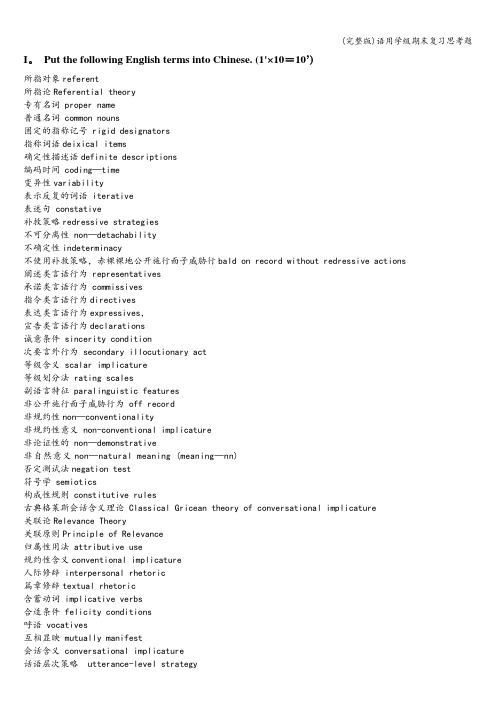
I。
Put the following English terms into Chinese. (1'×10=10’)所指对象referent所指论Referential theory专有名词 proper name普通名词 common nouns固定的指称记号 rigid designators指称词语deixical items确定性描述语definite descriptions编码时间 coding—time变异性variability表示反复的词语 iterative表述句 constative补救策略redressive strategies不可分离性 non—detachability不确定性indeterminacy不使用补救策略,赤裸裸地公开施行面子威胁行bald on record without redressive actions 阐述类言语行为 representatives承诺类言语行为 commissives指令类言语行为directives表达类言语行为expressives,宣告类言语行为declarations诚意条件 sincerity condition次要言外行为 secondary illocutionary act等级含义 scalar implicature等级划分法 rating scales副语言特征 paralinguistic features非公开施行面子威胁行为 off record非规约性non—conventionality非规约性意义 non-conventional implicature非论证性的 non—demonstrative非自然意义non—natural meaning (meaning—nn)否定测试法negation test符号学 semiotics构成性规则 constitutive rules古典格莱斯会话含义理论 Classical Gricean theory of conversational implicature关联论Relevance Theory关联原则Principle of Relevance归属性用法 attributive use规约性含义conventional implicature人际修辞 interpersonal rhetoric篇章修辞textual rhetoric含蓄动词 implicative verbs合适条件 felicity conditions呼语 vocatives互相显映 mutually manifest会话含义 conversational implicature话语层次策略 utterance-level strategy积极面子positive face间接言语行为 indirect speech acts间接指令 indirect directives结语 upshots交际意图communicative intention可撤销性 cancellability可废弃性 defeasibility可推导性 calculability跨文化语用失误cross—cultural pragmatic failure跨文化语用学cross—cultural pragmatics命题内容条件 propositional content condition面子保全论 Face-saving Theory面子论 Face Theory面子威胁行为 Face Threatening Acts (FTAs)蔑视 flouting明示 ostensive明示-推理模式ostensive—inferential model摹状词理论Descriptions粘合程度 scale of cohesion篇章指示 discourse deixis前提 presupposition前提语 presupposition trigger强加的绝对级别absolute ranking of imposition确定谈话目的 establishing the purpose of the interaction确定言语事件的性质 establishing the nature of the speech event 确定性描述语 definite descriptions认知语用学 cognitive pragmatics上下文 co—text社会语用迁移sociopragmatic transfer社交语用失误 sociopragmatic failure施为句 performative省力原则 the principle of least effort实情动词 factive verbs适从向 direction of fit手势型用法 gestural usage首要言外行为 primary illocutionary act双重或数重语义模糊 pragmatic bivalence/ plurivalence顺应的动态性 dynamics of adaptability顺应性adaptability语境关系的顺应(contextual correlates of adaptability)、语言结构的顺应(structural objects of adaptability)、顺应的动态性(dynamics of adaptability)和顺应过程的意识程度(salience of the adaptation processes)。
语用学简论期末复习资料
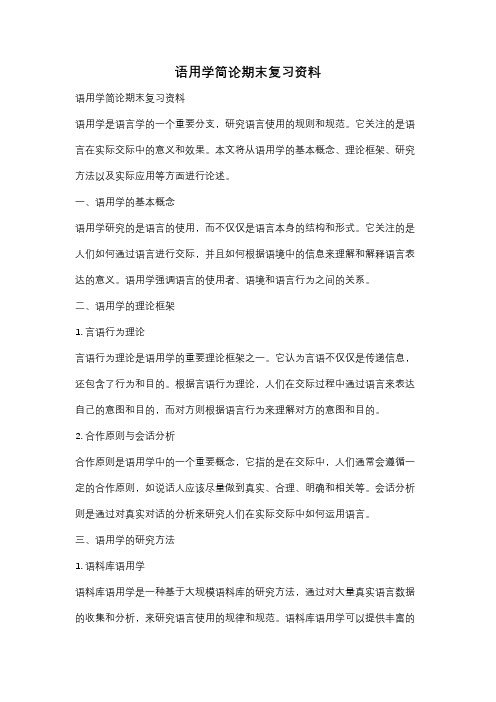
语用学简论期末复习资料语用学简论期末复习资料语用学是语言学的一个重要分支,研究语言使用的规则和规范。
它关注的是语言在实际交际中的意义和效果。
本文将从语用学的基本概念、理论框架、研究方法以及实际应用等方面进行论述。
一、语用学的基本概念语用学研究的是语言的使用,而不仅仅是语言本身的结构和形式。
它关注的是人们如何通过语言进行交际,并且如何根据语境中的信息来理解和解释语言表达的意义。
语用学强调语言的使用者、语境和语言行为之间的关系。
二、语用学的理论框架1. 言语行为理论言语行为理论是语用学的重要理论框架之一。
它认为言语不仅仅是传递信息,还包含了行为和目的。
根据言语行为理论,人们在交际过程中通过语言来表达自己的意图和目的,而对方则根据语言行为来理解对方的意图和目的。
2. 合作原则与会话分析合作原则是语用学中的一个重要概念,它指的是在交际中,人们通常会遵循一定的合作原则,如说话人应该尽量做到真实、合理、明确和相关等。
会话分析则是通过对真实对话的分析来研究人们在实际交际中如何运用语言。
三、语用学的研究方法1. 语料库语用学语料库语用学是一种基于大规模语料库的研究方法,通过对大量真实语言数据的收集和分析,来研究语言使用的规律和规范。
语料库语用学可以提供丰富的实证数据,从而支持语用学的理论研究。
2. 调查问卷和实验研究调查问卷和实验研究是语用学常用的研究方法。
通过设计问卷和实验,研究者可以获取被试者对于语言使用的态度、理解和解释等方面的数据,从而分析语言使用规律。
四、语用学的实际应用1. 跨文化交际语用学的研究成果可以应用于跨文化交际中。
不同的文化背景和价值观会影响人们对语言的理解和使用。
通过了解不同文化中的语用规范和交际习惯,人们可以更好地进行跨文化交际。
2. 社交媒体和网络交际随着社交媒体和网络交际的兴起,语用学在这一领域的应用也越来越重要。
人们在网络上的语言使用往往与实际交际有所不同,语用学可以帮助我们理解网络语言的特点和规律,从而更好地进行网络交际。
语用学复习题
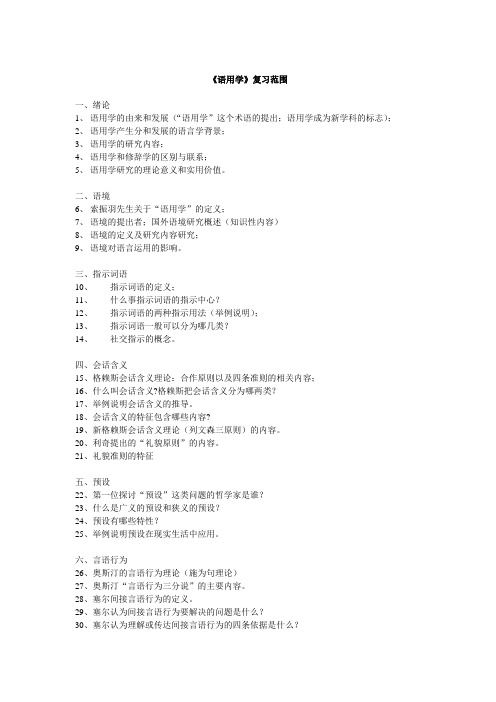
《语用学》复习范围一、绪论1、语用学的由来和发展(“语用学”这个术语的提出;语用学成为新学科的标志);2、语用学产生分和发展的语言学背景;3、语用学的研究内容;4、语用学和修辞学的区别与联系;5、语用学研究的理论意义和实用价值。
二、语境6、索振羽先生关于“语用学”的定义;7、语境的提出者;国外语境研究概述(知识性内容)8、语境的定义及研究内容研究;9、语境对语言运用的影响。
三、指示词语10、指示词语的定义;11、什么事指示词语的指示中心?12、指示词语的两种指示用法(举例说明);13、指示词语一般可以分为哪几类?14、社交指示的概念。
四、会话含义15、格赖斯会话含义理论:合作原则以及四条准则的相关内容;16、什么叫会话含义?格赖斯把会话含义分为哪两类?17、举例说明会话含义的推导。
18、会话含义的特征包含哪些内容?19、新格赖斯会话含义理论(列文森三原则)的内容。
20、利奇提出的“礼貌原则”的内容。
21、礼貌准则的特征五、预设22、第一位探讨“预设”这类问题的哲学家是谁?23、什么是广义的预设和狭义的预设?24、预设有哪些特性?25、举例说明预设在现实生活中应用。
六、言语行为26、奥斯汀的言语行为理论(施为句理论)27、奥斯汀“言语行为三分说”的主要内容。
28、塞尔间接言语行为的定义。
29、塞尔认为间接言语行为要解决的问题是什么?30、塞尔认为理解或传达间接言语行为的四条依据是什么?31、为什么说塞尔对发展完善言语行为理论做出了重要贡献?32、言语行为理论的功绩。
七、会话结构33、语用学为什么要研究会话结构?(p184)34、会话结构所涉及的几个概念:A、轮流说话B、相邻对C、修正机制D、预示序列35、总体结构(开端、本体、结束语)考试题型:一、填空题(本大题共10小题,每小题1分,共10分)二、判断分析题: (本大题共5小题,每小题4分,共20分)判断正误,在题后的括号内,正确的划上“√”,错误的划上“╳”,并改正。
语言学概论思考题
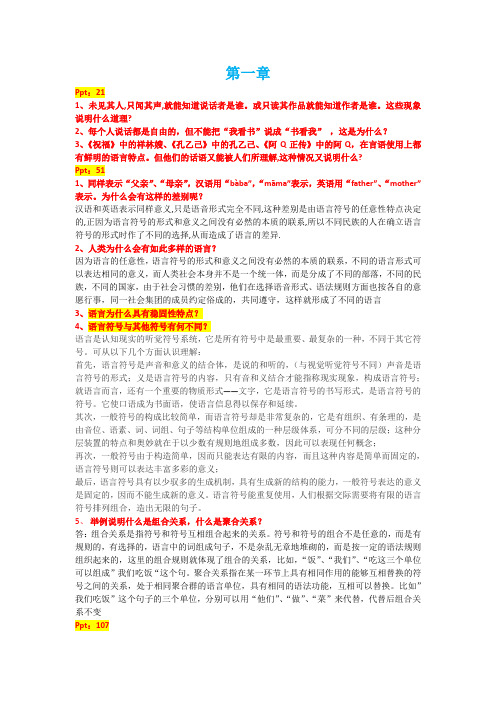
第一章Ppt:211、未见其人,只闻其声,就能知道说话者是谁。
或只读其作品就能知道作者是谁。
这些现象说明什么道理?2、每个人说话都是自由的,但不能把“我看书”说成“书看我”,这是为什么?3、《祝福》中的祥林嫂、《孔乙己》中的孔乙己、《阿Q正传》中的阿Q,在言语使用上都有鲜明的语言特点。
但他们的话语又能被人们所理解,这种情况又说明什么?Ppt:511、同样表示“父亲”、“母亲”,汉语用“bàba”,“māma”表示,英语用“father”、“mother”表示。
为什么会有这样的差别呢?汉语和英语表示同样意义,只是语音形式完全不同,这种差别是由语言符号的任意性特点决定的,正因为语言符号的形式和意义之间没有必然的本质的联系,所以不同民族的人在确立语言符号的形式时作了不同的选择,从而造成了语言的差异.2、人类为什么会有如此多样的语言?因为语言的任意性,语言符号的形式和意义之间没有必然的本质的联系,不同的语言形式可以表达相同的意义,而人类社会本身并不是一个统一体,而是分成了不同的部落,不同的民族,不同的国家,由于社会习惯的差别,他们在选择语音形式、语法规则方面也按各自的意愿行事,同一社会集团的成员约定俗成的,共同遵守,这样就形成了不同的语言3、语言为什么具有稳固性特点?4、语言符号与其他符号有何不同?语言是认知现实的听觉符号系统,它是所有符号中是最重要、最复杂的一种,不同于其它符号。
可从以下几个方面认识理解:首先,语言符号是声音和意义的结合体,是说的和听的,(与视觉听觉符号不同)声音是语言符号的形式;义是语言符号的内容,只有音和义结合才能指称现实现象,构成语言符号;就语言而言,还有一个重要的物质形式——文字,它是语言符号的书写形式,是语言符号的符号。
它使口语成为书面语,使语言信息得以保存和延续。
其次,一般符号的构成比较简单,而语言符号却是非常复杂的,它是有组织、有条理的,是由音位、语素、词、词组、句子等结构单位组成的一种层级体系,可分不同的层级;这种分层装置的特点和奥妙就在于以少数有规则地组成多数,因此可以表现任何概念;再次,一般符号由于构造简单,因而只能表达有限的内容,而且这种内容是简单而固定的,语言符号则可以表达丰富多彩的意义;最后,语言符号具有以少驭多的生成机制,具有生成新的结构的能力,一般符号表达的意义是固定的,因而不能生成新的意义。
语用学期末复习
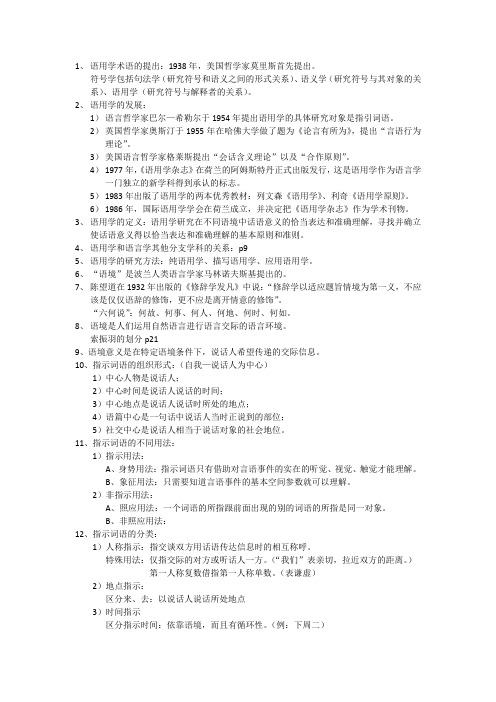
1、语用学术语的提出:1938年,美国哲学家莫里斯首先提出。
符号学包括句法学(研究符号和语义之间的形式关系)、语义学(研究符号与其对象的关系)、语用学(研究符号与解释者的关系)。
2、语用学的发展:1)语言哲学家巴尔—希勒尔于1954年提出语用学的具体研究对象是指引词语。
2)英国哲学家奥斯汀于1955年在哈佛大学做了题为《论言有所为》,提出“言语行为理论”。
3)美国语言哲学家格莱斯提出“会话含义理论”以及“合作原则”。
4)1977年,《语用学杂志》在荷兰的阿姆斯特丹正式出版发行,这是语用学作为语言学一门独立的新学科得到承认的标志。
5)1983年出版了语用学的两本优秀教材:列文森《语用学》、利奇《语用学原则》。
6)1986年,国际语用学学会在荷兰成立,并决定把《语用学杂志》作为学术刊物。
3、语用学的定义:语用学研究在不同语境中话语意义的恰当表达和准确理解,寻找并确立使话语意义得以恰当表达和准确理解的基本原则和准则。
4、语用学和语言学其他分支学科的关系:p95、语用学的研究方法:纯语用学、描写语用学、应用语用学。
6、“语境”是波兰人类语言学家马林诺夫斯基提出的。
7、陈望道在1932年出版的《修辞学发凡》中说:“修辞学以适应题旨情境为第一义,不应该是仅仅语辞的修饰,更不应是离开情意的修饰”。
“六何说”:何故、何事、何人、何地、何时、何如。
8、语境是人们运用自然语言进行语言交际的语言环境。
索振羽的划分p219、语境意义是在特定语境条件下,说话人希望传递的交际信息。
10、指示词语的组织形式:(自我—说话人为中心)1)中心人物是说话人;2)中心时间是说话人说话的时间;3)中心地点是说话人说话时所处的地点;4)语篇中心是一句话中说话人当时正说到的部位;5)社交中心是说话人相当于说话对象的社会地位。
11、指示词语的不同用法:1)指示用法:A、身势用法:指示词语只有借助对言语事件的实在的听觉、视觉、触觉才能理解。
B、象征用法:只需要知道言语事件的基本空间参数就可以理解。
(完整word版)语用学期末复习
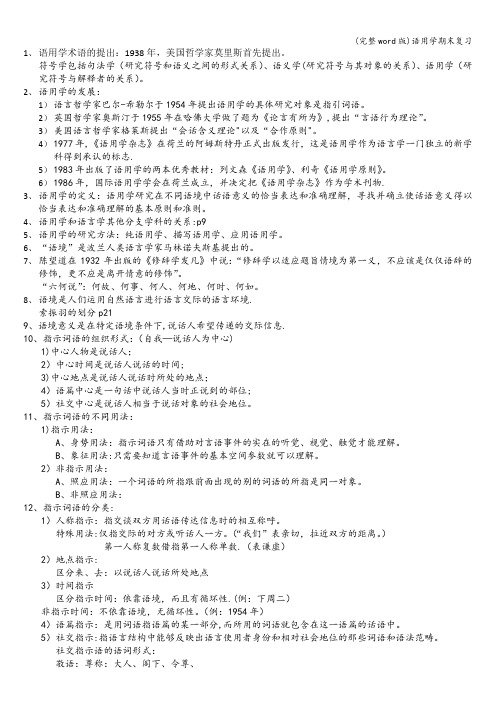
1、语用学术语的提出:1938年,美国哲学家莫里斯首先提出。
符号学包括句法学(研究符号和语义之间的形式关系)、语义学(研究符号与其对象的关系)、语用学(研究符号与解释者的关系)。
2、语用学的发展:1)语言哲学家巴尔-希勒尔于1954年提出语用学的具体研究对象是指引词语。
2)英国哲学家奥斯汀于1955年在哈佛大学做了题为《论言有所为》,提出“言语行为理论”。
3)美国语言哲学家格莱斯提出“会话含义理论"以及“合作原则"。
4)1977年,《语用学杂志》在荷兰的阿姆斯特丹正式出版发行,这是语用学作为语言学一门独立的新学科得到承认的标志.5)1983年出版了语用学的两本优秀教材:列文森《语用学》、利奇《语用学原则》。
6)1986年,国际语用学学会在荷兰成立,并决定把《语用学杂志》作为学术刊物.3、语用学的定义:语用学研究在不同语境中话语意义的恰当表达和准确理解,寻找并确立使话语意义得以恰当表达和准确理解的基本原则和准则。
4、语用学和语言学其他分支学科的关系:p95、语用学的研究方法:纯语用学、描写语用学、应用语用学。
6、“语境”是波兰人类语言学家马林诺夫斯基提出的。
7、陈望道在1932年出版的《修辞学发凡》中说:“修辞学以适应题旨情境为第一义,不应该是仅仅语辞的修饰,更不应是离开情意的修饰”。
“六何说”:何故、何事、何人、何地、何时、何如。
8、语境是人们运用自然语言进行语言交际的语言环境.索振羽的划分p219、语境意义是在特定语境条件下,说话人希望传递的交际信息.10、指示词语的组织形式:(自我—说话人为中心)1)中心人物是说话人;2)中心时间是说话人说话的时间;3)中心地点是说话人说话时所处的地点;4)语篇中心是一句话中说话人当时正说到的部位;5)社交中心是说话人相当于说话对象的社会地位。
11、指示词语的不同用法:1)指示用法:A、身势用法:指示词语只有借助对言语事件的实在的听觉、视觉、触觉才能理解。
英语专业语用学期末考试复习整理汇总.doc
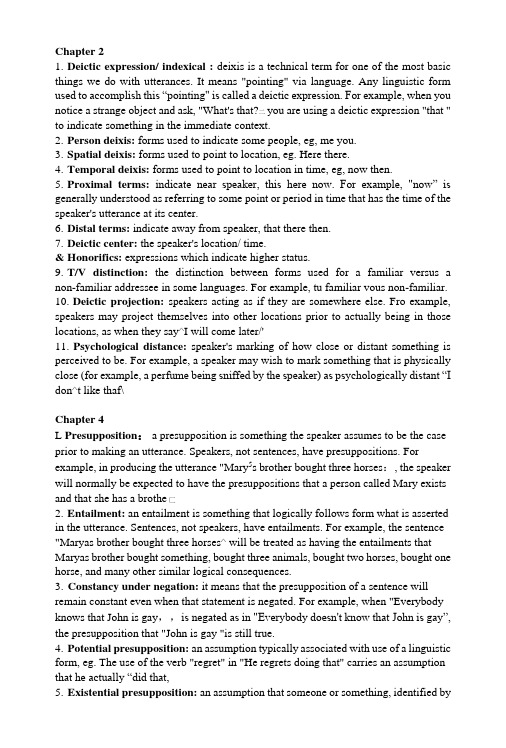
Chapter 21.Deictic expression/ indexical : deixis is a technical term for one of the most basic things we do with utterances. It means "pointing" via language. Any linguistic form used to accomplish this “pointing" is called a deictic expression. For exampl e, when you notice a strange object and ask, "What's that?二you are using a deictic expression "that " to indicate something in the immediate context.2.Person deixis: forms used to indicate some people, eg, me you.3.Spatial deixis: forms used to point to location, eg. Here there.4.Temporal deixis: forms used to point to location in time, eg, now then.5.Proximal terms: indicate near speaker, this here now. For example, "now” is generally understood as referring to some point or period in time that has the time of the speaker's utterance at its center.6.Distal terms: indicate away from speaker, that there then.7.Deictic center: the speaker's location/ time.& Honorifics: expressions which indicate higher status.9.T/V distinction: the distinction between forms used for a familiar versus a non-familiar addressee in some languages. For example, tu familiar vous non-familiar.10.Deictic projection: speakers acting as if they are somewhere else. Fro example, speakers may project themselves into other locations prior to actually being in those locations, as when they say^I will come later/'11.Psychological distance: speaker's marking of how close or distant something is perceived to be. For example, a speaker may wish to mark something that is physically close (for example, a per fume being sniffed by the speaker) as psychologically distant “I don^t like thaf\Chapter 4L Presupposition:a presupposition is something the speaker assumes to be the case prior to making an utterance. Speakers, not sentences, have presuppositions. For example, in producing the utterance "Mary5s brother bought three horses:, the speaker will normally be expected to have the presuppositions that a person called Mary exists and that she has a brothe匚2.Entailment: an entailment is something that logically follows form what is asserted in the utterance. Sentences, not speakers, have entailments. For example, the sentence "Maryas brother bought three horses^ will be treated as having the entailments that Maryas brother bought something, bought three animals, bought two horses, bought one horse, and many other similar logical consequences.3.Constancy under negation: it means that the presupposition of a sentence will remain constant even when that statement is negated. For example, when "Everybody knows that John is gay,,is negated as in "Everybody doesn't know that John is gay”, the presupposition that "John is gay "is still true.4.Potential presupposition: an assumption typically associated with use of a linguistic form, eg. The use of the verb "regret" in "He regrets doing that" carries an assumption that he actually “did that,5.Existential presupposition: an assumption that someone or something, identified byuse of a noun phrase, does exist. For example, the noun phrase "your car55 assumes the presupposition that “you have a car".6.Factive presupposition: the assumption that information stated after certain words, eg, "know" "regref\ is true. For example, the utterance that 'Tm glad that it,s over^ assumes the truth that “It,s ovef\7.Lexical presupposition: the assumption that, in using one word, the speaker can act as if another meaning will be understood. For example, each time you say that someone "managed^ to do something, the asserted meaning is that the person succeeded in some way.& Structural presupposition: the assumption that part of a structure contained information being treated as already known. For example, the wh-question construction like “when did he leave?'; is interpreted with the presupposition that the information after the wh-form, "he left,: is already known to be the case.9.Non-factive presupposition: the assumption that certain information, like that associated with verbs "drearrT, "imagine^and "pretend^, is not true. For example, when you say^I dreamed that I was rich: the presupposition is that what follows the word "dreamed^ is not true. That is “I was not rich:10.Counter-factive presupposition: the assumption that certain information is the opposite of true. For example, a conditional clause like "If I had a car59 presents the truth that I dorf t have a car.11.Projection problem: the meaning of some presuppositions (as parts) doesn^t survive to become the meaning of some complex sentences (as wholes). For example, the presupposition "Kelly was ilF is assumed to be true in the simple structure “No body realized that Kelly was ilF\ But it is not true in the complex structure that “I imagined that Kelly was ill and nobody realized that she was ilF\12.Background entailments: all logical consequence of an utterance・ For example, the background entailments of "Rover chased three dogs” can be "something chased three dogs,;"Rover did something to three dogs':or "Rover chased three of something^ and so on.13.Foreground entailment: the main logical consequence of an utterance. For example, when Rover is the foc us of the utterance "Rover chased three dogs”,the main assumption is that something chased three dogs.Chapter 51.Tautology: an apparently meaningless expression in which one word is defined as itself, eg. Business is business.2.Implicature/ Conversational implicature: an additional unstated meaning that has to be assumed in order to maintain the cooperative principle, eg. If someone says “The President is a mouse ”,something that is literally false, the hearer must assume the speaker means to convey more than is being said.3.Cooperative principle: a basic assumption in conversation that each participant will attempt to contribute appropriately, at the required time, to the cuirent exchange of talk.Four sub-principles of the cooperative principle are called maxims:Quantity(1)make your contribution as informative as is required (for the current purposes of the exchange).(2)do not make your contribution more informative than is required.QualityTry to make your contribution one that is true.(1)do not say what you believe to be false.(2)Do not say that for which you lack adequate evidence.RelationBe relevantMannerBe perspicuous.(1)avoid obscurity of expression.(2)Avoid ambiguity.(3)Be brief (avoid unnecessary prolixity).(4)Be orderly.4.HedgesCertain kinds of expressions speakers use to mark that they may be in danger of not fully adhering to the principles.Show speakers be cautious of the ...maximQuality: as far as I know I may be mistaken Fm not sure I guessQuantity: as you probably know to cut a long story short I won't bore you with all the detailsRelation: I doift know if this is important, but this may sound like a dumb question, but Manner: this may be a bit confused, but Vm not sure if this makes sense I don^t know if this is clear at all.5.Generalized conversational implicature: an additional unstated meaning that does not depend on special or local knowledge. For example, phrases like a/an X are typically interpreted according to the generalized conversational implicature that: an X +> not speaker^ X6.Scalar implicature: an additional meaning of the negative of any value higher on the scale than the one uttered, e.g. In saying "some children",I create an implicature that what I say does not apply to "all children^.7.Particularized conversational implicature: an additional unstated meaning that depends on special or local knowledge. For example, here is a dialogue. Rick: Hey, coming to the wild party tonight ? Tom: My parents are visiting. In order to make Tom's response relevant, Rick has to draw on some assumed knowledge that one college student in this setting expects another to have. Tom will be spending that evening with his parents, and time spent with parents is quiet (consequently +> Tom not at party). 8.Conventional implicature: as additional unstated meaning associated with the use of a specific word, e.g. “A but implies a contrast between A and B,so "contrast^ is a conventional implicature of “but:Chapter 61.Speech act: an action performed by the use of an utterance to communicate, such as apology, complaint, compliment, invitation, promise, or request.2.Speech event: a set of circumstances in which people interact in some conventional way to arnve at some outcome.3- On any occasion, the action performed by producing an utterance will consist of three related acts.Locutionary act: the basic act of utterance or producing a meaningful linguistic expression. If you have difficulty with actually forming the sounds and words to create a meaningful utterance in a language(for example,because iVs foreign or you are tongue-tied ),you might fail to produce a locutionary act.Illocutionary act/ force: the communicative force of an utterance. For example, we might utter 'Tve just made some coffee.^ to make a statement, an offer, an explanation or for some other communicative purpose.Perlocutionary act/ effect: the effect of an utterance used to perform a speech act. For example, you will utter “I have just made some coffee” on the assumption that the hearer will recognize the effect you intended (for example, to account for a wonderful smell, or to get the hearer to drink some coffee).4.IFIDs illocutionary force indicating device: indication in the speaker^ utterance of the communicative force of that utterance. It is an expression where there is a slot for a performative verb that explicitly names the illocutionary act being performed. Like I promise you that I will see you later. Other IFIDs which can be identified are word order, stress and intonation.5.Performative verb: a verb that explicitly names the speech act, e.g. The verb “promise" in the utterance "I promise to be there"\6.Felicity conditions: the appropriate conditions for a speech act to be recognized as intended. For some clear cases, the performance will be infelicitous if the speaker is not a specific person in a special context. General conditions: preconditions on performing a speech act. For example, participants can understand the language being used and that they are not play-acting or being nonsensical. Content conditions: in order to count as a particular type of speech act, an utterance must contain certain features, e.g. A promise must be a future event. Preparatory conditions: specific requirements prior to an utterance in order for it to count as a particular speech act. For example, when I promise to do something, there are two preparatory conditions: the event will not happen by itself; the event will have a beneficial effect. Sincerity conditions: requirements on the genuine intentions of a speaker in order for an utterance to count as a particular speech act. For example, for a promise, the speaker genuinely intends to carry out the future action. Essential condition: in performing a speech act, a requirement that the utterance commits the speaker to the act performed. For example, by the act of uttering a promise,I thereby intend to create an obligation to carry out the action as promised.7.Performative hypothesis: a proposal that, underlying every utterance, there is a clause with a verb that identifies the speech act. The basic format is I (hereby) Vp you (that) UExplicit performative: a speech act containing a performative verb.I hereby orderyou that you clean up this mess.Implicit performative: a speech act without a performative verb. Clean up this mess!8.Speech act classificationOne general classification system lists five types of general functions performed by speech acts: declarations, representatives, expressives, directives, and commissives. Declarations are those kinds of speech acts that change the world via their utterance.E.g. A judge pronouncing a sentence.Representatives are those kinds of speech acts that state what the speaker believes to be the case or not, like assertions, conclusions, and descriptions. The speaker makes words fit the world of belief. For example, the earth is flat.Expresssives are those kinds of speech acts that state what the speaker feels, like statements of pleasurejikes, painjoy and so on. The speaker makes words fit the world of feeling. For example, Fm really sorry!Directives are those kinds of speech acts that speakers use to get someone else to do something, like commands, requests, orders, suggestions and so on. The speaker attempts to make the world fit the words via the hearer. For example, gimme a cup of coffee.Commissives are those kinds of speech acts that speakers use to commit themselves to some future action, like promises, threats, refusals and so on. The speaker undertakes to make the world fit the words via the speaker.9.Direct speech act: speech act where a direct relationship exists between the structure and communicative function of an utterance, e.g. Using an interrogative form (can you....?) to ask a question.10.Indirect speech act: speech act where an indirect relationship exists between the structure and communicative function of an utterance, e.g. The use of an interrogative (can you...?) not to ask a question, but to make a request (can you help me with this?) Chapter 71.Face means the public self-image of a person. It refers to that emotional and social sense of self that everyone has and expects everyone else to recognize.2.Politeness in an interaction, can then be defined as the means employed to show awareness of another person,s face.3.Face wants: a person's expectations that their public self-image will be respected.4.FTA/Face threatening acts: utterance or action which threatens a person's public self-image.5.Face saving act: utterance or action which avoids a potential threat to a personas public self-image. For example, Fm going to tell him to stop that awful noise right now! Perhaps you could just ask him if he is going to stop soon because it is getting a bit late and people need to get to sleep.6.Negative face is the need to be independent, to have freedom of action, and not to be imposed on by others.7.Positive face is the need to be accepted, even liked, by others, to be treated as a member of the same group, and to know that his or her wants are shared by others.8.Negative politeness: a face saving act which is oriented to the personas negative face will tend to show deference, emphasize the importance of the other9s time or concerns.9.Positive politeness: a face saving act which is concerned with the person's positive face will tend to show solidarity, emphasize that both speakers want the same thing, and that they have a common goal.10・Off record: utterances not directly addressed to another.11.On record: utterances directly addressed to another.12.Bald on record: utterances, e.g. Orders, directly addressed to another where the illocutionary force is made explicit. For example, lend me your pen.13.Mitigating devices is expressions used to soften an imposition, eg please, would you.14.A positive politeness strategy leads the requester to appeal to a common goal, and even friendship, via expressions like “How about letting me use your pen?”15.A negative politeness strategy is an attempt to demonstrate awareness of another's rights not to be imposed on. Like could you lend me a pen?16・Solidarity strategy is the tendency to use positive politeness forms, emphasizing closeness between speaker and heare匸Eg. Come on, let's go to the party. Everyone will be there・ We will have fun.17.Deference strategy is the tendency to use negative politeness forms, emphasizing the hearer5s right to freedom. Eg. There^s going to be a party, if you can make it, it will be fun.18.Pre-sequencesOne way of avoiding risk of threatening others' face is to provide an opportunity for the other to halt the potentially risky act.Pre-request: utterance before a request to check if a request can be made. Eg. Are you busy? Not really. Check over this memo. Okay.Pre-invitation: utterance before an invitation to check if an invitation can be made. Eg. Are you doing anything later? Oh, yeah, busy busy. Oh, okay.Pre-arniouncement: utterance before an announcement to check if an announcement can be made. Eg. Mom, guess what happened? Silence. Mom, you know what? Not right now, Jacy, Fm busy.(stop).。
语用学复习要点及习题
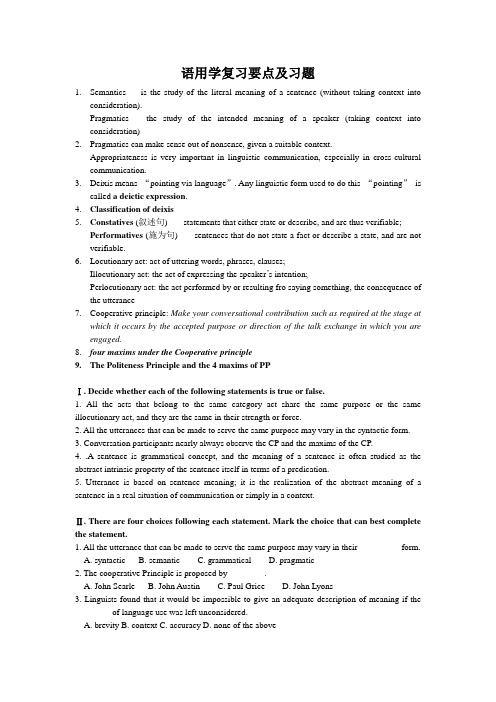
语用学复习要点及习题1.Semantics---- is the study of the literal meaning of a sentence (without taking context intoconsideration).Pragmatics---- the study of the intended meaning of a speaker (taking context into consideration)2.Pragmatics can make sense out of nonsense, given a suitable context.Appropriateness is very important in linguistic communication, especially in cross-cultural communication.3.Deixis means “pointing via language”. Any linguistic form used to do this “pointing”iscalled a deictic expression.4.Classification of deixis5.Constatives (叙述句) ---- statements that either state or describe, and are thus verifiable;Performatives (施为句) ---- sentences that do not state a fact or describe a state, and are not verifiable.6.Locutionary act: act of uttering words, phrases, clauses;Illocutionary act: the act of expressing the speaker’s intention;Perlocutionary act: the act performed by or resulting fro saying something, the consequence of the utterance7.Cooperative principle: Make your conversational contribution such as required at the stage atwhich it occurs by the accepted purpose or direction of the talk exchange in which you are engaged.8.four maxims under the Cooperative principle9.The Politeness Principle and the 4 maxims of PPⅠ. Decide whether each of the following statements is true or false.1. All the acts that belong to the same category act share the same purpose or the same illocutionary act, and they are the same in their strength or force.2. All the utterances that can be made to serve the same purpose may vary in the syntactic form.3. Conversation participants nearly always observe the CP and the maxims of the CP.4. .A sentence is grammatical concept, and the meaning of a sentence is often studied as the abstract intrinsic property of the sentence itself in terms of a predication.5. Utterance is based on sentence meaning; it is the realization of the abstract meaning of a sentence in a real situation of communication or simply in a context.Ⅱ. There are four choices following each statement. Mark the choice that can best complete the statement.1. All the utterance that can be made to serve the same purpose may vary in their _________ form.A. syntacticB. semanticC. grammaticalD. pragmatic2. The cooperative Principle is proposed by ________.A. John SearleB. John AustinC. Paul GriceD. John Lyons3. Linguists found that it would be impossible to give an adequate description of meaning if the ________ of language use was left unconsidered.A. brevityB. contextC. accuracyD. none of the above4. Of the three speech acts, linguistic are most interested in the _________.A. locutionary actB. perlocutionary actC. illocutionary actD. none of the above5. The maxim of quantity requires: ___________.A. make your contribution ad informative as required.B. Do not make contribution more informative than is required.C. Do not say that for which you lack adequate evidence.D. Both A and B6. The maxim of quality requireds: do not say what you believe to be ________.A. falseB. trueC. briefD. orderly7. Most of the violations of the maxims of the CP give rise to _______.A. utterance meaningB. speech act theoryC. conversational implicaturesD. all of the above.8. The significance of Grice’s CP lies in that it explains how it is possible for the speaker to convey _________ is literally said.A. more thanB. less thanC. the same asD. none of the above.Ⅲ. Answer the following question as comprehensively as possible. Give examples for illustration if necessary.1. How does a sentence meaning differ from an utterance meaning?KeyF T F T TA CBCD A C AA sentence meaning is of-ten considered as the intrinsic property of the sentence itself in terms of a predication. It is abstract and independent of context. The meaning of an utterance is concrete, and context-dependent. The utterance meaning is based on sentence meaning; it is realization of the abstract meaning of a sentence in a real situation of communication, or simply in a context. For example, “There is a dog at the door”. The speaker could utter it as a matter-of-fact statement, telling the hearer that the dog is at the door. The speaker could use it as a warning, asking the hearer not to approach the door. There are other possibilities, too. So, the understanding of the utterance meaning of “There is a dog at the door”depends on the context in which it is uttered and the purpose for which the speaker utters it.。
《语言学概论》复习思考题

《语言学概论》复习思考题导言1.了解语言学的三大发源地。
2.语言交际过程分为哪几个阶段?3.古代的语言研究和今天的语言研究有什么不同?西欧和我国的语言研究走上独立发展道路的转折点是什么?4.我国传统语文学的“小学”指什么?5.对语言本身的研究,大致可以分为三大部分?第一章语言的社会功能1.语言的作用是什么?为什么说语言是人类最重要的交际工具?为什么说文字是语言最重要的辅助性交际工具?2.为什么说语言实际上是一种特殊的社会现象?3.正确理解“语言是思维的工具”。
4.语言有没有阶级性?说明理由。
5.任何一种语言所包含的句子的数量都是无限的,人类为什么能在有限的时间里掌握语言?第二章语言是符号系统1.举例说明什么是符号,符号由哪些因素构成?为什么说语言是一种符号系统?2.就语言符号而言,什么是形式?什么是意义?它们的相互关系有什么特点?掌握语言符号的特点——任意性和线条性。
3.语言符号的系统性表现在哪些方面?理解语言是一个层级体系。
理解语言符号的组合关系和聚合关系。
重要名词概念:符号二层性组合关系聚合关系第三章语音1.语音的物理属性和生理属性。
2.元音和辅音的特点及区别。
3.掌握与普通话及各主要方言有关的国际音标符号。
4.什么叫音位和音位变体?确立和归纳音位应该遵循的原则是什么?5.理解音质音位和非音质音位。
6.举例说明音位的区别特征。
7.举例说明汉语音节结构的特点。
8.理解常见的语流音变现象——同化、异化、弱化、脱落。
重要名词概念:音素音位音节音位变体音质音位非音质音位第四章语法1.理解语法的基本单位——句子、词组、词、语素。
2.掌握并能分析词的组合的基本类型。
3.理解语法意义、语法形式和语法手段及相互关系。
4.理解并分析语言的结构层次。
5.理解语法范畴中的一些基本概念的内涵。
重要名词概念:语法意义语法形式语法范畴语法手段形态第五章词义1.什么是词的词汇意义。
2.理解词义概括性的表现形式。
3.认识多义词和它的产生条件。
《语言学概论》复习思考题整理
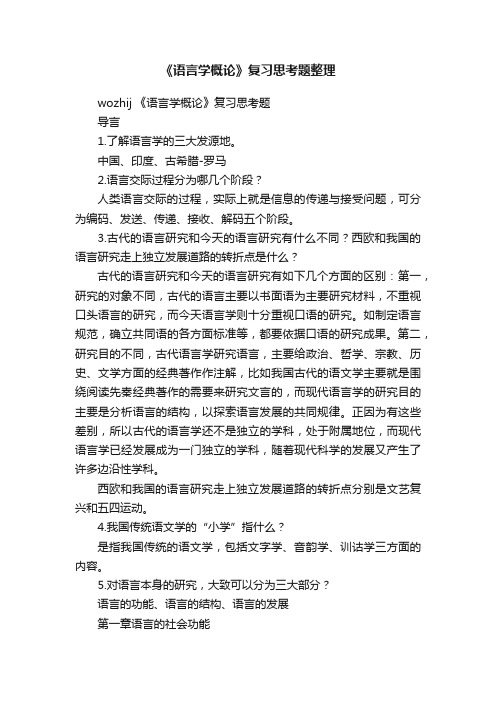
《语言学概论》复习思考题整理wozhij 《语言学概论》复习思考题导言1.了解语言学的三大发源地。
中国、印度、古希腊-罗马2.语言交际过程分为哪几个阶段?人类语言交际的过程,实际上就是信息的传递与接受问题,可分为编码、发送、传递、接收、解码五个阶段。
3.古代的语言研究和今天的语言研究有什么不同?西欧和我国的语言研究走上独立发展道路的转折点是什么?古代的语言研究和今天的语言研究有如下几个方面的区别:第一,研究的对象不同,古代的语言主要以书面语为主要研究材料,不重视口头语言的研究,而今天语言学则十分重视口语的研究。
如制定语言规范,确立共同语的各方面标准等,都要依据口语的研究成果。
第二,研究目的不同,古代语言学研究语言,主要给政治、哲学、宗教、历史、文学方面的经典著作作注解,比如我国古代的语文学主要就是围绕阅读先秦经典著作的需要来研究文言的,而现代语言学的研究目的主要是分析语言的结构,以探索语言发展的共同规律。
正因为有这些差别,所以古代的语言学还不是独立的学科,处于附属地位,而现代语言学已经发展成为一门独立的学科,随着现代科学的发展又产生了许多边沿性学科。
西欧和我国的语言研究走上独立发展道路的转折点分别是文艺复兴和五四运动。
4.我国传统语文学的“小学”指什么?是指我国传统的语文学,包括文字学、音韵学、训诂学三方面的内容。
5.对语言本身的研究,大致可以分为三大部分?语言的功能、语言的结构、语言的发展第一章语言的社会功能1.语言的作用是什么?为什么说语言是人类最重要的交际工具?为什么说文字是语言最重要的辅助性交际工具?语言的作用:语言是人类社会的交际工具。
每个社会,无论它是经济发达的社会,还是经济十分落后的社会,都必须有自己的语言,都离不开语言这个交际工具,语言是组成社会必不可少的一个因素,是人类与动物相区别的重要特征之一。
语言是联系社会成员的桥梁和纽带,没有语言,人类无法交际,人与人之间的联系就会中断,社会就会崩溃,不复存在。
语言学概论各章思考题
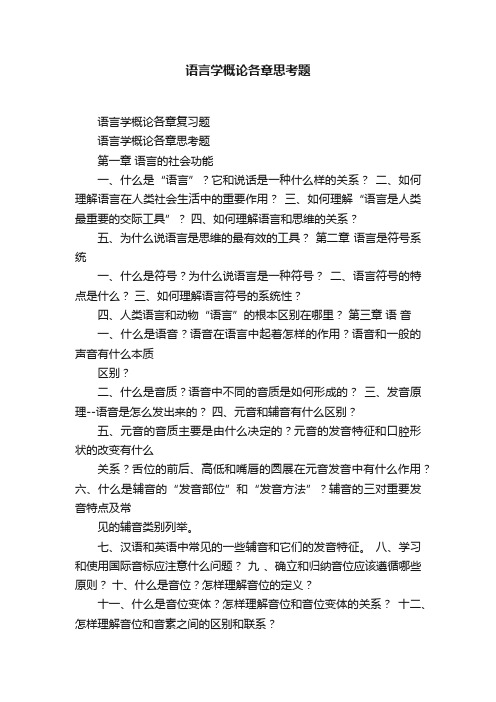
语言学概论各章思考题语言学概论各章复习题语言学概论各章思考题第一章语言的社会功能一、什么是“语言”?它和说话是一种什么样的关系?二、如何理解语言在人类社会生活中的重要作用?三、如何理解“语言是人类最重要的交际工具”?四、如何理解语言和思维的关系?五、为什么说语言是思维的最有效的工具?第二章语言是符号系统一、什么是符号?为什么说语言是一种符号?二、语言符号的特点是什么?三、如何理解语言符号的系统性?四、人类语言和动物“语言”的根本区别在哪里?第三章语音一、什么是语音?语音在语言中起着怎样的作用?语音和一般的声音有什么本质区别?二、什么是音质?语音中不同的音质是如何形成的?三、发音原理--语音是怎么发出来的?四、元音和辅音有什么区别?五、元音的音质主要是由什么决定的?元音的发音特征和口腔形状的改变有什么关系?舌位的前后、高低和嘴唇的圆展在元音发音中有什么作用?六、什么是辅音的“发音部位”和“发音方法”?辅音的三对重要发音特点及常见的辅音类别列举。
七、汉语和英语中常见的一些辅音和它们的发音特征。
八、学习和使用国际音标应注意什么问题?九、确立和归纳音位应该遵循哪些原则?十、什么是音位?怎样理解音位的定义?十一、什么是音位变体?怎样理解音位和音位变体的关系?十二、怎样理解音位和音素之间的区别和联系?十三、音位的区别特征和具体的音位系统有怎样的关系?区别特征和音位的聚合的关系是什么?十四、什么是音节?怎样理解音节的形成?十五、汉语普通话音节结构有哪些主要特点?语言学概论各章复习题第四章语法一、语法规则具有怎样的特性?语法的组合规则和聚合规则存在着怎样的联系?二、怎样理解词的定义?怎样把词和语素及词组区别开来?三、构词语素和变词语素有什么不同?四、可以用什么方法判定和区分词的组合的五种基本结构类型?五、什么是语法意义?怎样理解语法意义和语法形式之间的关系?六、怎样理解句法组合的层次性?七、什么是语法结构规则的递归性?递归性和层次性有什么关系?八、词类的划分需要遵循怎样的标准?词类的划分和句法结构的分析和描写有什么关系?九、什么是句法同义?变换和句法同义有怎样的关系?十、什么是句法多义?变换分析对揭示和分化句法多义有怎样的作用?第五章词义一、什么是基本词汇?基本词汇的特点是什么?基本词汇包含的词有哪些重要类型?二、什么是一般词汇?如何区别基本词汇和一般词汇?三、怎样理解词义的概括性?四、什么是多义词和单义词?语言中为什么会有多义词现象?五、词义派生的条件是什么?什么是隐喻和换喻?六、怎样理解同义词现象?怎样辨析同义词?七、反义词有哪两种主要类型?怎样区分反义词的两种类型?八、词义组合有些什么样的特点?第六章文字和书面语一、文字的作用是什么?二、文字是记录语言的书写符合系统。
语用学思考题最后版
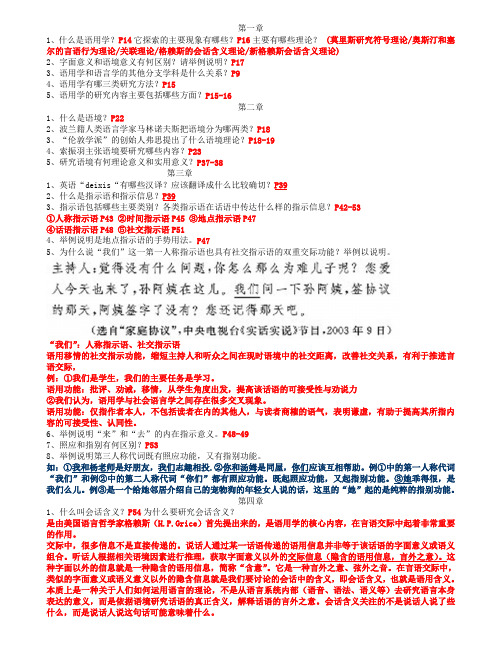
第一章1、什么是语用学?P14它探索的主要现象有哪些?P16主要有哪些理论?(莫里斯研究符号理论/奥斯汀和塞尔的言语行为理论/关联理论/格赖斯的会话含义理论/新格赖斯会话含义理论)2、字面意义和语境意义有何区别?请举例说明?P173、语用学和语言学的其他分支学科是什么关系?P94、语用学有哪三类研究方法?P155、语用学的研究内容主要包括哪些方面?P15-16第二章1、什么是语境?P222、波兰籍人类语言学家马林诺夫斯把语境分为哪两类?P183、“伦敦学派”的创始人弗思提出了什么语境理论?P18-194、索振羽主张语境要研究哪些内容?P235、研究语境有何理论意义和实用意义?P37-38第三章1、英语“deixis“有哪些汉译?应该翻译成什么比较确切?P392、什么是指示语和指示信息?P393、指示语包括哪些主要类别?各类指示语在话语中传达什么样的指示信息?P42-53①人称指示语P43 ②时间指示语P45 ③地点指示语P47④话语指示语P48 ⑤社交指示语P514、举例说明是地点指示语的手势用法。
P475、为什么说“我们”这一第一人称指示语也具有社交指示语的双重交际功能?举例以说明。
“我们”:人称指示语、社交指示语语用移情的社交指示功能,缩短主持人和听众之间在现时语境中的社交距离,改善社交关系,有利于推进言语交际,例:①我们是学生,我们的主要任务是学习。
语用功能:批评、劝诫,移情,从学生角度出发,提高该话语的可接受性与劝说力②我们认为,语用学与社会语言学之间存在很多交叉现象。
语用功能:仅指作者本人,不包括读者在内的其他人,与读者商榷的语气,表明谦虚,有助于提高其所指内容的可接受性、认同性。
6、举例说明“来”和“去”的内在指示意义。
P48-497、照应和指别有何区别?P538、举例说明第三人称代词既有照应功能,又有指别功能。
如:①我和杨老师是好朋友,我们志趣相投.②你和汤姆是同屋,你们应该互相帮助。
语用学复习题
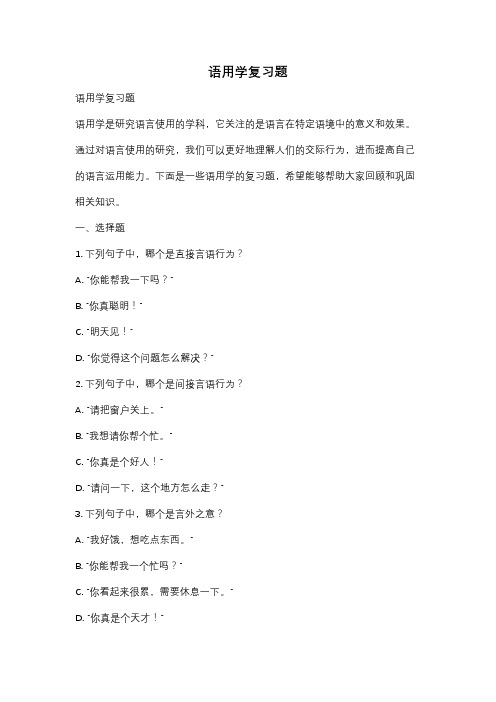
语用学复习题语用学复习题语用学是研究语言使用的学科,它关注的是语言在特定语境中的意义和效果。
通过对语言使用的研究,我们可以更好地理解人们的交际行为,进而提高自己的语言运用能力。
下面是一些语用学的复习题,希望能够帮助大家回顾和巩固相关知识。
一、选择题1. 下列句子中,哪个是直接言语行为?A. "你能帮我一下吗?"B. "你真聪明!"C. "明天见!"D. "你觉得这个问题怎么解决?"2. 下列句子中,哪个是间接言语行为?A. "请把窗户关上。
"B. "我想请你帮个忙。
"C. "你真是个好人!"D. "请问一下,这个地方怎么走?"3. 下列句子中,哪个是言外之意?A. "我好饿,想吃点东西。
"B. "你能帮我一个忙吗?"C. "你看起来很累,需要休息一下。
"D. "你真是个天才!"4. 下列句子中,哪个是言下之意?A. "我喜欢你的新发型。
"B. "你能不能别这么吵?"C. "你真是个好朋友!"D. "你觉得这个问题怎么解决?"5. 下列句子中,哪个是直接表示言外之意?A. "我好饿,想吃点东西。
"B. "你真是个聪明的孩子!"C. "你看起来很累,需要休息一下。
"D. "你觉得这个问题应该怎么解决?"二、判断题1. 言语行为是指通过语言表达出来的行为。
2. 言语行为可以分为直接言语行为和间接言语行为。
3. 言外之意是指通过语言表达出来的真实意图。
4. 言下之意是指通过语言表达出来的含蓄意味。
5. 言外之意和言下之意在语用学中是同一个概念。
语言学概论思考题期末考试复习题
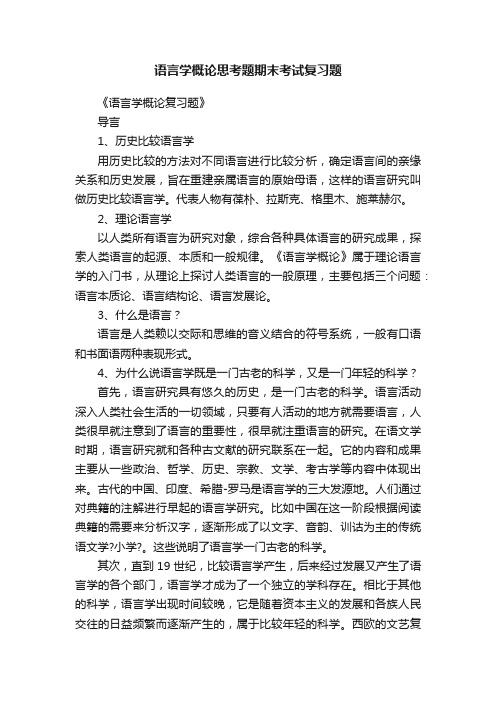
语言学概论思考题期末考试复习题《语言学概论复习题》导言1、历史比较语言学用历史比较的方法对不同语言进行比较分析,确定语言间的亲缘关系和历史发展,旨在重建亲属语言的原始母语,这样的语言研究叫做历史比较语言学。
代表人物有葆朴、拉斯克、格里木、施莱赫尔。
2、理论语言学以人类所有语言为研究对象,综合各种具体语言的研究成果,探索人类语言的起源、本质和一般规律。
《语言学概论》属于理论语言学的入门书,从理论上探讨人类语言的一般原理,主要包括三个问题:语言本质论、语言结构论、语言发展论。
3、什么是语言?语言是人类赖以交际和思维的音义结合的符号系统,一般有口语和书面语两种表现形式。
4、为什么说语言学既是一门古老的科学,又是一门年轻的科学?首先,语言研究具有悠久的历史,是一门古老的科学。
语言活动深入人类社会生活的一切领域,只要有人活动的地方就需要语言,人类很早就注意到了语言的重要性,很早就注重语言的研究。
在语文学时期,语言研究就和各种古文献的研究联系在一起。
它的内容和成果主要从一些政治、哲学、历史、宗教、文学、考古学等内容中体现出来。
古代的中国、印度、希腊-罗马是语言学的三大发源地。
人们通过对典籍的注解进行早起的语言学研究。
比如中国在这一阶段根据阅读典籍的需要来分析汉字,逐渐形成了以文字、音韵、训诂为主的传统语文学?小学?。
这些说明了语言学一门古老的科学。
其次,直到19世纪,比较语言学产生,后来经过发展又产生了语言学的各个部门,语言学才成为了一个独立的学科存在。
相比于其他的科学,语言学出现时间较晚,它是随着资本主义的发展和各族人民交往的日益频繁而逐渐产生的,属于比较年轻的科学。
西欧的文艺复兴,中国的五四运动都为语言学的发展创造了条件。
此外,语言学还与其他学科紧密相联。
由于语言的产生和物理、生理、心理等学科有关,现代汉语中的语言又和数学等科学有联系。
语言学和其他学科联系在一起有产生了社会语言学、心理语言学、统计语言学等。
《语言学导论》复习思考题
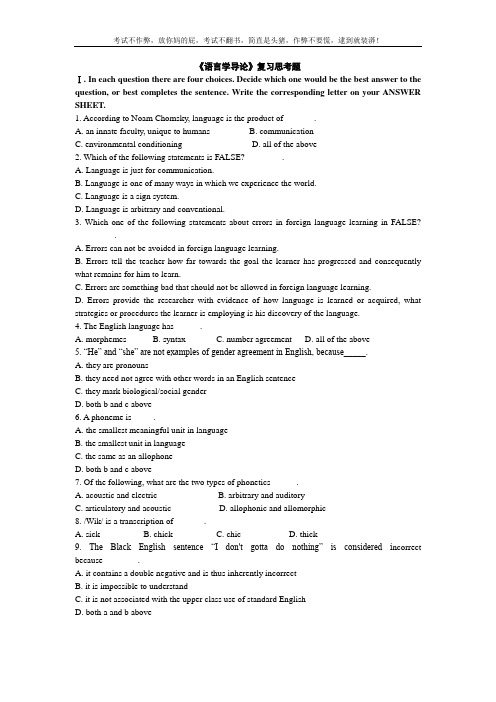
《语言学导论》复习思考题Ⅰ. In each question there are four choices. Decide which one would be the best answer to the question, or best completes the sentence. Write the corresponding letter on your ANSWER SHEET.1. According to Noam Chomsky, language is the product of_______.A. an innate faculty, unique to humansB. communicationC. environmental conditioningD. all of the above2. Which of the following statements is FALSE? ________.A. Language is just for communication.B. Language is one of many ways in which we experience the world.C. Language is a sign system.D. Language is arbitrary and conventional.3. Which one of the following statements about errors in foreign language learning in FALSE? _________.A. Errors can not be avoided in foreign language learning.B. Errors tell the teacher how far towards the goal the learner has progressed and consequently what remains for him to learn.C. Errors are something bad that should not be allowed in foreign language learning.D. Errors provide the researcher with evidence of how language is learned or acquired, what strategies or procedures the learner is employing is his discovery of the language.4. The English language has______.A. morphemesB. syntaxC. number agreementD. all of the above5. “He” and “she” are not examples of gender agreement in English, because_____.A. they are pronounsB. they need not agree with other words in an English sentenceC. they mark biological/social genderD. both b and c above6. A phoneme is_____.A. the smallest meaningful unit in languageB. the smallest unit in languageC. the same as an allophoneD. both b and c above7. Of the following, what are the two types of phonetics______.A. acoustic and electricB. arbitrary and auditoryC. articulatory and acousticD. allophonic and allomorphic8. /Wik/ is a transcription of_______.A. sickB. chickC. chicD. thick9. The Black English sentence “I don't gotta do nothing” is considered i ncorrect because________.A. it contains a double negative and is thus inherently incorrectB. it is impossible to understandC. it is not associated with the upper class use of standard EnglishD. both a and b above10. The use of non-standard English persists because_______.A. the working class is incapable of speaking “correctly”B. English is a complicated and therefore difficult language to masterC. subordinate groups use non-standard English to promote solidarityD. teachers do not properly stress the importance of standard English in schools11. True or false: Chinese has no inflections for grammatical case. ______.A. TrueB. False12. What is defined as 'the study of sentence structure'? ______.A. MorphologyB. SemanticsC. PhonologyD. Syntax13. ______ refers to the fact that there is no necessary or logical relationship between a linguistic form and its meaning. ______.A. DisplacementB. creativityC. arbitrarinessD. duality14. The study of a language at some point of time is called________.A. computational linguisticsB. sociolinguisticsC. diachronic linguisticsD. synchronic linguistics15. ________ refers to the abstract linguistic system shared by all the members of a speech communityA. LangueB. performanceC. competenceD. parole16. Traditional grammar is ________.A. descriptiveB. prescriptiveC. non-Latin-basedD. wrong17. ______ is the branch of linguistics which studies the characteristics of speech sounds and provides methods for their description, classification and transcription.A. PhonologyB. Phonetic alphabetC. Corpus linguisticsD. Phonetics18. _____ is the minimal unit in the sound system of a language, which is of distinctive value.A. AllophoneB. PhoneC. PhonemeD. Morpheme19. Which of the following factors does not help to identify a word? ______.A. Relative shortnessB.Relative uninterruptibilityC. A minimum free formD. Stability20. Speech act theory was initially developed by _______.A. HallidayB. AustinC. SearleD. Grice21. The four major modes of semantic change are_______.A. extension, narrowing, elevation and degradationB. extension, generalization, elevation and degradationC. extension, narrowing, specialization and degradationD. extension, elevation, amelioration and degradation22. The relation between the two words “husband” and “wife” can be d escribed as____.A. gradable antonymyB. converse antonymyC. complementary antonymyD. synonymy23. “friendly” is a _______.A. compoundB. inflectional wordC. derivativeD. morpheme24. The construction “honest people” is _______.A. a coordinate constructionB. an exocentric constructionC. an endocentric constructionD. an immediate constituent25. The word “brunch” and “motel” are _______.A. formed by blendingB. acronymsC. coined by back-formationD. clipped words26. The function of the sentence “A nice day, isn’t it?” is _______.A. directiveB. informativeC. performativeD. phatic27. Which of the following sounds is a voiced bilabial stop? ______.A. [m]B. [v]C. [p]D. [b]28. Which of the following sounds is a voiceless affricate? _______.A. [w]B. [f]C. [tF]D. [dV]29. In the sentence “Can I have a bite to drink?” the speaker may not have a p roblem with competence, but with_______.A. performanceB. utteranceC. syntaxD. context30. The phrase “Colorful ideas sleep furiously” is an example of_______.A. rapport talkB. indexical languageC. an ungrammatical but acceptable sentenceD. a grammatical but unacceptable sentence31. There are ______ morphemes in the word “children’s”A. sixB. twoC. threeD. four32. The words “take” and “table” are called _______ because they can stand as a word by themselves.A. inflectional morphemesB. free morphemesC. stemsD. roots33. Identify the morphemes in the word 'unimaginative':A. un-im-ag-in-at-iveB. un-imaginativeC. un-imagin-ativeD. unimagin-ative34. Which of the following two-term sets shows the feature of complementarity? _______.A. Husband/ WifeB. Alive/DeadC. Hot/ ColdD. White/ Black35. The Whorf Hypothesis claims that________.A. language is full of “rich points”, whose meanings are difficult to translate into another languageB. abstract terms are easily translatableC. accents are part of identityD. language influences culture-specific ways of knowing36. The phrase ‘time is a commodity’ is an example of_______.A. The Whorf HypothesisB. A metaphoric systemC. A non-standard varietyD. A rich point37. The last phoneme in the word “hang” is a _______.A. glottalB. palatalC. dentalD. nasal38. Three places of articulation that involve the teeth and/or the lips are:A. palatal, velar, glottalB. bilabial, labiodental, dentalC. stop, fricative, affricativeD. nasal, lateral, semi vowel39. In the sentence 'I took my big brown cat to the vet yesterday', which of the following does not appear? _______.A. AdjectiveB. PrepositionC. AdverbD. Conjunction40. What is the meaning relationship between the two words “plant/grass”? ______.A. HomonymyB. AntonymyC. HyponymyD. Allomorphs41. The syl labic structure of the word “linguistics” is ______.A. CVCCVCCVCCB. CVCCCVCCVCCC. CVCCVVCCVCCD. CVCVVCCVCC42. The phonetic transcription with diacritics is called _____.A. broad transcriptionB. International Phonetic AlphabetC. American English PronunciationD. narrow transcription43. The Black English sentence “I don't gotta do nothing” is considered incorrect because:a) it contains a double negative and is thus inherently incorrectb) it is impossible to understandc) it is not associated with the upper class use of standard Englishd) both a and b above44. According to their ______, words can classified into closed-class and open-class words.A. variabilityB. membershipC. similaritiesD. functions45. When language is used to "do things", it serves the _____ function.A. evocativeB. expressiveC. directiveD. performative46. "Classroom" is a _______.A. free morphemeB. derivativeC. compoundD. root.47. The phrase “time is a commodity” is an example of_______.A. The Whorf HypothesisB. A metaphoric systemC. A non-standard varietyD. A rich point48. _______ is a type of phonological process by which one sound takes on some or all the characteristics of a neighboring sound.A. AssimilationB. TransformationC. Code-switchingD. interference49. _______ refers to the use of a native language pattern or rule which leads to an error or inappropriate form in the target language.A. InterlanguageB. Positive transferC. Negative transferD. Overgeneralization50. In the sentence “I took my big brown cat to the vet yesterday”, which of the following does not appear? _______.A. AdjectiveB. PrepositionC. AdverbD. Conjunction51. _______ is that part of the meaning of word or phrase that relates it to phenomena in the real world or in a fictional or possible world.A. ConnotationB. Affective meaningC. DenotationD. Sense52. A linguist regards the changes in language and language use as ______.A. unnaturalB. something to be fearedC. naturalD. abnormal53. The semantic components of the word “boy” can be expressed as _____.A. +human, +male, +adultB. +human, -male, +adultC. +human, -male, -adultD. +human, +male, -adult54. Conjunctions, preposition, pronouns and articles can be classified as ____.A. lexical wordsB. grammatical wordsC. pro-formsD. content words55. If two sounds are of no distinctive value, but are varieties of the same phoneme, they arecalled ______.A. phonesB. speech soundsC. allophonesD. morphs56. In the following sounds, _____ is a voiced stop.A. [b]B. [d]C. [p]D. [k]57. “You stand up” is transformed into “Stand up”. Which transformational rule is used according to TG Grammar? _____.A. CopyingB. AdditionC. ReorderingD. Deletion58. The words such as TOFEL, NATO, UFO are _____.A. formed by blendingB. acronymsC. coined by back formationD. clipped words59. The words such as “brunch”, “motel” are _______.A. formed by blendingB. acronymsC. coined by back formationD. clipped words60. ______ are produced when the obstruction is complete at first, then released slowly with friction resulting from partial obstruction.A. NasalsB. GlidesC. FricativesD. Affricatives61. “A fish is swimming in the pond” is transformed into“There is a fish swimming in the pond”. Which of the following transformational rules is used? ______.A. CopyingB. AdditionC. ReorderingD. Deletion62. “The man put on his hat” is transformed into “The man put his hat on”. Which transformational rule is applied here? _______.A. CopyingB. AdditionC. ReorderingD. Deletion63. The function of the sentence “A nice day, isn’t it?” is ______.A. directiveB. informativeC. emotiveD. phatic64. Which of the following sounds is a voiceless bilabial stop? _____.A. [m]B. [f]C. [p]D. [b]65. Which of the following languages is a tone language?A. RussianB. ChineseC. EnglishD. French66. ________ speaking, no variety of language is better than or superior to others.A. GenerallyB. SociallyC. PoliticallyD. Linguistically67. Grammar-based language learning and teaching fails partially because _____.A. still no precise information is obtained concerning how grammar can be learnedB. grammar can not be taught at allC. it is useless to teach grammar in language classesD. learners can learn better without grammar68.For foreign language learners to achieve effective learning, the input should_____.A. not be so far beyond their reach that they are overwhelmedB. be interesting and simpleC. not be so close to their current stage that they are not challenged at allD. Both A and C69. Interlanguage is _____.A. is produced by every foreign language learnersB. a mixtur e of the learner’s mother tongue and the target languageC. imperfect compared with the target language, but it is not mere translation from the learner’snative languageD. Both A and C70. Error analysis may be carried out in order to______.A. identify strategies which learners use in language learningB. try to identify the causes of learner errors.C. obtain information on common difficulties in language learningD. All of the above.71. Many Chinese English learners may, at the beginning stage, produ ce “mans” and “photoes” as the plural forms of “man” and “photo”. This is most likely the result of _______ in the process of foreign language learning.A. Negative transferB. OvergeneralizationC. Positive transferD. mother tongue interference72. Which of the following qualities is not the requirement of a good test? _______.A. ObjectivityB. ReliabilityC. ValidityD. Both A and C73. Which of the following statements about machine translation is likely to be wrong? _______.A. Machine translation has always been a chief concern in computational linguistics.B. There are areas where machine translation surpasses human translations.C. Sooner or later, machine translation will replace human translation completely.D. In some areas, human translations surpasses machine translation.74. Teaching culture in our language classes can _______.A. get the students familiar with cultural differencesB. help the students transcend their own culture and see things as the members of the target culture willC. emphasize the inseparability of understanding language and understanding culture through various classroom practicesD. All of the above.75. According to Grice’s theory, a conversational implicature arises when the cooperative principle and its maxims are _______.A. strictly observedB. secretly and deliberately violatedC. blatantly or apparently violatedD. Both A and BⅡ. Match each of the following terms in Column A with one of the appropriate definitions in Column B. Write the corresponding letter on your ANSWER SHEET.Part OneColumn A1. constituent2. complementary distribution3. design features4. diglossia5. displacement6. homonymy7. language interference8. registers9. selectional restrictions10. semantic anomalyColumn BA. the phenomenon that human language can cope with any subject whatever, and it does not matter how far away the topic of conversation is in time and spaceB. the framework proposed by Hockett, which discusses the defining properties of human language as against animal communicationC. the restrictions on the type of noun that can be selected with each verbD. the type of language which is selected as appropriate to a type of situationE. the phenomena that allophones occur in different phonetic environmentsF. a sociolinguistic situation where two varieties of a language exist side by side throughout the community, with each having a definite role to playG. the case that two, or more meanings may be associated with the same linguistic formH. the case that one of the arguments or the predicate of the main predication is self-contradictoryI. any linguistic form or group of linguistic forms that appears at the bottom of one of the lines in the tree diagram of the syntactic analysisJ. the use of elements from one language while speaking another.Part TwoColumn A1. duality of structure2. free morphemes3. endocentric construction4. International Phonetic Alphabet5. Psycholinguistics6. the syntagmatic relation7. derivational morphemes8. regional dialect9. sequential rules10. presuppositionColumn BA. the study of the relationship between language and mind.B. the bound morphemes which are conjoined to other morphemes (or words) to derive or form a new wordC. the organization of language into two levels: a lower level of sounds which combine to form a higher level of meaningful unitsD. a standardized and internationally accepted system of phonetic transcription.E. linguistic varieties used by people living in different regions.F. the rules which govern the combination of sounds in a particular language.G. one whose distribution is functionally equivalent, or approaching equivalence, to one of its constituentsH. the kind of meaning which the speaker doesn't assert but assumes the hearer can identify from the sentenceI. the morphemes which can constitute words by themselvesJ. the one between one item and others in a linear sequence, or between elements which are allpresentPart ThreeColumn A1.antonymy2. blending3. compounds4. arbitrariness5. cultural transmission6. diachronic linguistics7. distinctive features8. standard dialect9. ultimate constituent10. CreoleColumn BA. the study of the language development or change over timeB. the features that a phoneme has and that distinguish it from other phonemesC. the words that are produced by stringing together wordsD. the smallest grammatical unit obtained through binary segmentationE. a particular variety of a language, not related to any particular group of language usersF. a language formed when a pidgin has become the primary language of a speech communityG. word formed by combining parts of other wordsH. the fact that the details of the linguistic system must be learned anew by each speakerI. the oppositeness of meaning between lexemesJ. a design feature of language which refers to the fact that there is no logical connection between the signifier and the signified of a sign.Part FourColumn A1. a proposition2. a speech community3. an utterance4. bilingualism5. constatives6. performatives7. registers8. sociolect9. the Whorf-Sapir hypothesis10. utterance meaningColumn BA. the suggestion that different languages carve the world up in different ways, and that as a result their speakers think about it differentlyB. something conveyed by a sentence in a context other than its literal meaningC. varieties of language that are related to useD. a piece of language actually used in a particular contextE. the linguistic variety used by people belonging to a particular social classF. a community the members of which have or believe they have at least one common variety of languageG. what is expressed by a declarative sentence when that sentence is uttered to make a statementH. sentences which describe or state something; they are either true or falseI. the situation where at least two languages are used side by side by an individual or by a group of speakers, with each having a different role to playJ. sentences that do not describe things and cannot be said to be true or falsePart FiveColumn A1. an analytic proposition2. binary cutting3. connotation4. derivation5. lexicology6. logical semantics7. reference8. semantic feature9. the chain relation10. the choice relationColumn BA. the relation holding between one item and others in a linear sequence, or between elements which are all presentB. the basic unit of meaning in a wordC. the study of the meaning of a sentence in terms of its truth conditionsD. one whose grammatical form and lexical meaning make it necessarily true, without reference to external criteriaE. the additional meanings that a word or phrase has beyond its central meaningF. a relation holding between elements replaceable with each other at a particular place in a structureG. the morphological process in which affixes are added to the stemH. the concrete entities that have the properties denoted by words or phrasesI. the practice to cut a grammatical construction into two parts and then cut each of the two parts into two and continue with this segmentation until we reach the smallest grammatical unit, the morphemeJ. the study of the vocabulary items of a language, including their meanings and relations, their classification and collocation, and changes in their form and meaning through timeIV.SHORT-ANSWER QUESTIONS: Answer the following question in 60 to 120 words. Write your answer on the ANSWER SHEET.1. Is Cantonese better than Shanghai Dialect?2. How can a linguist make his work the scientific study of language?3. What are the design features of language?4. What is the distinction between competence and performance?5. What are the branches of linguistics?6. Why are speech and writing treated differently in linguistics?7. What is the distinction among phone, phoneme, and allophone?8. How are the English words classified?9. What is IC Analysis? Can you name one of its advantages in analyzing the structure of sentences?10. In second language learning, should grammar be taught in language classes?V. ESSAY QUESTION. Develop the following topic into an essay of 150 to 220 words. Write your answer on the ANSWER SHEET.1. How should errors on the part of foreign language learners be treated?2. What is an indirect speech act?3. How can the English speech sounds be classified?4. Exemplify what conversational implicatures are and how they arise.5. What is a register?《语言学导论》复习思考题答案1. A2. A3. C4. D5. D6. B7. C8. D9. C 10. C11. A 12. D 13. C 14. D 15. A 16. B 17. D 18. C 19. A 20. B21. A 22. B 23. C 24. C 25. D 26. D 27. D 28. C 29. A 30. D31. C 32. B 33. C 34. B 35. D 36. B 37. D 38. B 39. D 40. C41. B 42. D 43. C 44. B 45. D 46. C 47. B 48. A 49. C 50. D51. C 52. C 53. D 54. B 55. C 56. A 57. D 58. B 59. A 60. D61. B 62. C 63. D 64. C 65. B 66. D 67. A 68. D 69. D 70. D71. B 72. A 73. C 74. D 75. CPart One1. I2. E3. B4. F5. A6. G7. J8. D9. C 10. HPart Two1. C2. I3. G4. D5. A6. J7. B8. E9. F 10. HPart Three1. I2. G3. C4. J5. H6. A7. B8. E9. D 10. FPart Four1. G2. F.3. D4. I5. H6. J7. C8. E9. A 10. BPart Five1. D2. I3. E4. G5. J6. C7. H8. B9. A 10. F1. The answer is no. ①As a social phenomenon, language is closely related to the structure of the society in which it is used, and the evaluation of a language or a variety of a language is entirely social. ②To the professional linguist, all language forms and accents are equally good, because they all fulfill the communicative function they are expected to fulfill and each of them has its own complex and delicate systems of grammatical rules and speech sounds. ③A certain variety of language appears to be superior to others maybe because the areas where that variety is spoken is economically or socially more influential, or because the variety is spoken by the class of people possessing higher social, political, and/or economical status.2. In order to make his analysis scientific, a linguist is usually guided by four principles: exhaustiveness, consistency, economy and objectivity. Exhaustiveness means he should gather all the materials relevant to the study and give them an adequate explanation, in spite of the complicated ness. He is to leave no linguistic “stone” unturned. Consistency means there should be no contradiction between different parts of the total statement. Economy means a linguist should pursue brevity in the analysis when it is possible. Objectivity implies that since some people may be subjective in the study, a linguist should be (or sound at least) objective, faithful to reality.3. The features that define human languages as against animal communication are generally called design features. The following are the frequently discussed ones. ①Arbitrariness, ②duality, ③creativity, ④displacement. (详见课件第一章1.2)4. This fundamental distinction is made by Chomsky in his Aspects of the Theory of Syntax. According to him, competence is an ideal language user’s underlying knowledge about the system of rules of his language, and performance refers to the actual use of this knowledge in utterances that is produced in concrete situations. Competence enables a speaker to produce and understand an indefinite number of sentences and to recognize grammatical mistakes and ambiguities. Aspeaker’s competence is stable while his performance is often influenced by psychological and social factors. So a speaker’s performance does not always match or equal his supposed competence. Chomsky believes that linguistics ought to study competence, rather than performance. In other words, they should discover what an ideal speaker knows about his native language.5. The study of language itself as a whole is called general linguistics or microlinguistics. The branches of general linguistics study different aspects of language itself. They are phonetics, phonology, morphology, (lexicon), syntax and semantics. The studies of language in relation to other disciplines, such as psychology, sociology, etc belong to macrolinguistics. Branches of Macrolinguistics include psycholinguistics, sociolinguistics, computational linguistics, anthropological linguistics, applied linguistics, and so on. (可以有选择地说几个分枝,但要掌握各自定义)6.While speech is the vocal/spoken form of language, writing is the written form of language. They belong to different systems though they may overlap. That speech is primary over writing is a general principle of linguistic analysis. First, speech existed long before writing systems came into being. Second, written forms just represent in this way or that the speech sounds. Third, genetically children learn to speak before learning to write. Everything considered, speech is believed to more representative of human language than writing. Most modern linguistic analysis is thus focused on speech, different from traditional grammar of the 19th century and therebefore. 7.Phone is a term used in phonetics to refer to the smallest perceptible discrete segment of sound in a stream of speech. Phones do not necessarily distinguish meaning. A phoneme is the minimal unit in the sound system of a language, according to traditional phonological theories; it is a unit that is of distinctive value. A phoneme is an abstract unit. It is not any particular sound, but rather it is represented or realized by a certain phone in a certain phonetic context. The phones that can represent a phoneme are called its allophones. For example, [p h] and [p=] are the allophones of the same phoneme /p/.8. 详见课件Chapter 3, Part One, 第三点。
语用学复习题
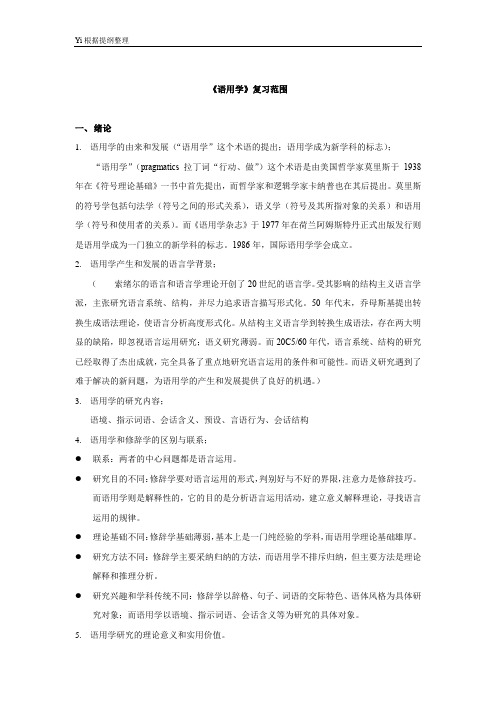
《语用学》复习范围一、绪论1.语用学的由来和发展(“语用学”这个术语的提出;语用学成为新学科的标志);“语用学”(pragmatics拉丁词“行动、做”)这个术语是由美国哲学家莫里斯于1938年在《符号理论基础》一书中首先提出,而哲学家和逻辑学家卡纳普也在其后提出。
莫里斯的符号学包括句法学(符号之间的形式关系),语义学(符号及其所指对象的关系)和语用学(符号和使用者的关系)。
而《语用学杂志》于1977年在荷兰阿姆斯特丹正式出版发行则是语用学成为一门独立的新学科的标志。
1986年,国际语用学学会成立。
2.语用学产生和发展的语言学背景;(索绪尔的语言和语言学理论开创了20世纪的语言学。
受其影响的结构主义语言学派,主张研究语言系统、结构,并尽力追求语言描写形式化。
50年代末,乔母斯基提出转换生成语法理论,使语言分析高度形式化。
从结构主义语言学到转换生成语法,存在两大明显的缺陷,即忽视语言运用研究;语义研究薄弱。
而20C5/60年代,语言系统、结构的研究已经取得了杰出成就,完全具备了重点地研究语言运用的条件和可能性。
而语义研究遇到了难于解决的新问题,为语用学的产生和发展提供了良好的机遇。
)3.语用学的研究内容;语境、指示词语、会话含义、预设、言语行为、会话结构4.语用学和修辞学的区别与联系;●联系:两者的中心问题都是语言运用。
●研究目的不同:修辞学要对语言运用的形式,判别好与不好的界限,注意力是修辞技巧。
而语用学则是解释性的,它的目的是分析语言运用活动,建立意义解释理论,寻找语言运用的规律。
●理论基础不同:修辞学基础薄弱,基本上是一门纯经验的学科,而语用学理论基础雄厚。
●研究方法不同:修辞学主要采纳归纳的方法,而语用学不排斥归纳,但主要方法是理论解释和推理分析。
●研究兴趣和学科传统不同:修辞学以辞格、句子、词语的交际特色、语体风格为具体研究对象;而语用学以语境、指示词语、会话含义等为研究的具体对象。
5.语用学研究的理论意义和实用价值。
- 1、下载文档前请自行甄别文档内容的完整性,平台不提供额外的编辑、内容补充、找答案等附加服务。
- 2、"仅部分预览"的文档,不可在线预览部分如存在完整性等问题,可反馈申请退款(可完整预览的文档不适用该条件!)。
- 3、如文档侵犯您的权益,请联系客服反馈,我们会尽快为您处理(人工客服工作时间:9:00-18:30)。
I. Put the following English terms into Chinese. (1'×10=10')所指对象referent所指论Referential theory专有名词proper name普通名词common nouns固定的指称记号rigid designators指称词语deixical items确定性描述语definite descriptions编码时间coding-time变异性variability表示反复的词语iterative表述句constative补救策略redressive strategies不可分离性non-detachability不确定性indeterminacy不使用补救策略,赤裸裸地公开施行面子威胁行bald on record without redressive actions 阐述类言语行为representatives承诺类言语行为commissives指令类言语行为directives表达类言语行为expressives,宣告类言语行为declarations诚意条件sincerity condition次要言外行为secondary illocutionary act等级含义scalar implicature等级划分法rating scales副语言特征paralinguistic features非公开施行面子威胁行为off record非规约性non-conventionality非规约性意义non-conventional implicature非论证性的non-demonstrative非自然意义non-natural meaning (meaning-nn)否定测试法negation test符号学semiotics构成性规则constitutive rules古典格莱斯会话含义理论Classical Gricean theory of conversational implicature 关联论Relevance Theory关联原则Principle of Relevance归属性用法attributive use规约性含义conventional implicature人际修辞interpersonal rhetoric篇章修辞textual rhetoric含蓄动词implicative verbs合适条件felicity conditions呼语vocatives互相显映mutually manifest会话含义conversational implicature话语层次策略utterance-level strategy积极面子positive face间接言语行为indirect speech acts间接指令indirect directives结语upshots交际意图communicative intention可撤销性cancellability可废弃性defeasibility可推导性calculability跨文化语用失误cross-cultural pragmatic failure 跨文化语用学cross-cultural pragmatics命题内容条件propositional content condition 面子保全论Face-saving Theory面子论Face Theory面子威胁行为Face Threatening Acts (FTAs)蔑视flouting明示ostensive明示-推理模式ostensive-inferential model摹状词理论Descriptions粘合程度scale of cohesion篇章指示discourse deixis前提presupposition前提语presupposition trigger强加的绝对级别absolute ranking of imposition确定谈话目的establishing the purpose of the interaction确定言语事件的性质establishing the nature of the speech event 确定性描述语definite descriptions认知语用学cognitive pragmatics上下文co-text社会语用迁移sociopragmatic transfer社交语用失误sociopragmatic failure施为句performative省力原则the principle of least effort实情动词factive verbs适从向direction of fit手势型用法gestural usage首要言外行为primary illocutionary act双重或数重语义模糊pragmatic bivalence/ plurivalence顺应的动态性dynamics of adaptability顺应性adaptability语境关系的顺应(contextual correlates of adaptability)、语言结构的顺应(structural objects of adaptability)、顺应的动态性(dynamics of adaptability)和顺应过程的意识程度(salience of the adaptation processes)。
说话人经济原则speaker’s economy损-惠等级cost-benefit scale所表达的心理状态expressed psychological state所指reference所指对象referent特殊性会话含义particularized conversational implicature条件性的双重言外行为conditional bivalent illocutionary act 调节性规则regulative rules投射问题projection problem推理论inference theory推理模式inferential model文学语用学literary pragmatics问卷调查questionnaire习语论idiom theory显性施为句explicit performatives显映manifest限定语篇长度策略space-making strategies相对权势relative power相邻对adjacency pair象征型用法symbolic usage小句含义clausal implicature协商性negotiability新格莱斯会话含义理论Neo-Gricean pragmatic theories of conversational implicature 新格莱斯语用学机制Neo-Gricean pragmatic apparatus心理表征mental representation信息意图informative intention行事动词performative verb宣告类言语行为declarations言后行为perlocutionary act言内行为locutionary act言外行为illocutionary act言外之的illocutionary point言外之力illocutionary force言外之力显示手段illocutionary force indicating devices (IFIDs)言语事件speech events言语行为speech act一般性会话含义generalized conversational implicature意义sense因果的、历史的所指论Causal or Historical Chains Theory隐性施为句implicit performatives优先结构preference structure语际语语用学interlanguage pragmatics语境context语境关系的顺应contextual correlates of adaptability 语码模式code model语篇标示discoursal indicator语篇性语用模糊discoursal ambivalence语言顺应论Adaptation Theory语言结构的顺应structural objects of adaptability 语言能力linguistic competence语义学semantics语用模糊pragmatic ambivalence语用能力pragmatic competence语用迁移pragmatic transfer语用失误pragmatic failure语用语言迁移pragmalinguistic transfer语用语言失误pragmalinguistic failure语用语言学pragmalinguistics与事实相反的条件句counterfactual conditionals蕴涵、推涵、衍推entailment期待的第二部分preferred second part预先的元语用评论语prospective MPCs再表述reformulations指号designator指令类言语行为directives追溯性的元语用评论retrospective MPCs指示投射deictic projection指示语/指示性词语deictic expressions指示性用法referential use指示中心deictic center准备条件preparatory condition着重受话人的元语用评论addressee-oriented metapragmatic comments ( A-MPCs) 着重说话人的元语用评论speaker-oriented metapragmatic comments (S-MPCs)自然意义natural meaning自我中心性egocentricity最大关联maximal relevance最佳关联optimal relevance配对比较paired comparison卡片分类card sorting等级划分rating scales开放性面谈open interview引发法elicitationII. Fill in the blanks with a proper word or words. (2'×10=20')1. How did Morris distinguish three aspects of semiotic inquiry?The use of the term is usually attributed to two American philosophers C. Morrisand R. Carnap, who first introduced the term ‘pragmatics’in their study of semiotics in the 1930s. Morris distinguished three aspects of semiotic inquiry, i.e. syntactics (or syntax), being the study of the ‘formal relation of signs to one another’, semantics, the study of the ‘relation of signs to the objects to which the signs are applicable, and pragmatics, the study of ‘the relation of signs to interpreters.’2. What are the two most important notions in Pragmatics?3. How does P. Grice distinguish meanings?The American philosopher P. Grice distinguishes between what he calls natural meaning (meaning-n) and non-natural meaning (meaning-nn). The two terms parallel ‘sentence meaning’and ‘speaker meaning’.4. What distinction did Frege make in 1952?The German philosopher Frege (1952) is generally credited with the distinction between the reference of a linguistic expression, ‘that to which the sign refers’, and its sense, an interpretation of the sign, provided by the grammar of the language.5. What are the two major philosophical theories about reference?referential theory of names and causal-historical theory6. What are the 2 distinct uses of definite descriptions?K.S. Donnellan (1966:285-286) called attention to what he called the ‘referential use,’as opposed to the ‘attributive use,’of a definite description.7. How many types of deictic expressions are there? What are they?Deictic expressions in English are usually classified into five main types: person deixis, spatial deixis, temporal deixis, social deixis, and discourse deixis.8. What are the two different uses of deictic expressions?There are basically two different uses of deictic expressions. They are called gestural usage and symbolic usage respectively.12. What are the two categories of utterances did Austin distinguish?Austin distinguished two categories of utterances, which he referred to respectively as ‘constatives’and ‘performatives.’9. Who made the greatest contribution to Speech Act Theory in the post-Austinian age?Most of the contributions to Speech Act Theory in the post-Austinian age are ascribed to the American philosopher-linguist John Searle.10. What distinction did Searle make about an utterance?Searle made the distinction between the illocutionary act and the propositional content of an utterance.11. What did IFID stand for?According to Searle, IFID stood for illocutionary force indicating devices. 12. What are the two types of rules that govern the linguistic communication according to Searle?Searle distinguishes two basic types of rules, i.e. regulative rules and constitutive rules.13. What are the three most important dimensions of variation in whichillocutionary acts differ from one another?Based on his criticism of Austin’s classification, Searle presented his taxonomy of illocutionary acts. He first of all specified 12 dimensions of variation in which illocutionary acts differ from one another. The most important of them are the following three: illocutionary point, direction of fit, and expressed psychological state.14. What are the five types of illocutionary speech acts that identified Searle’s taxonomy?It is mainly based on these three dimensions of difference that Searle builds his taxonomy, which identifies five types of illocutionary speech acts: (1) assertives/representatives,(2) directives,(3) commissives,(4) expressives,(5) declarations.15. What did Jenny Thomas think of indirect language as?Compared with direct language, indirect language is ‘costly and risky.’16. Searle believed that in performing indirect speech acts, there exist two speech acts. What are they?In performing indirect speech acts, two speech acts instead of one are involved,i.e. primary illocutionary act and secondary illocutionary act.17. What is the implied meaning termed in Grice’s theory.The implied meaning is termed conversational implicature in Grice’s theory.18. What are the most important properties of conversational implicature?Calculability, cancellability or defeasibility, nondetachability,non-conventionality, indeterminacy19. What do Sperber and Wison apply to language understanding?Sperber and Wison apply cognitive psychology and monetary economics to language understanding,20. What are the two models that Ostensive-Inferential Model base on?语码模式(Code Model)和推理模式(Inferential Model)21. What is relevance defined in terms of?Relevance is defined in terms of contextual effect and processing effort.22. What are the most important notions that Relevance Theory focus on?cognition and communication23. What are the most influential ones in the pragmatic studies of politeness?In the pragmatic studies of politeness, the most influential are Leech’s Politeness Principle and Brown & Levinson’s politeness strategies.24. What are the factors that measure the weightiness of a face-threatening act?The weightiness of a face-threatening act is measured by three factors: social distance, relative power and absolute ranking of impositions.25. What are the two aspects of face according to Brown & Levinson?Brown & Levinson define face as the public self-image of an individual, which has two aspects: first positive face, which represents an individual’s desire to be accepted and liked by others; second, there is negative face, which refers to an individual’s right to freedom of action and his/her need not to be imposed upon by others.26. What are the five sets of politeness strategies put forth by Brown & Levinson?P. 230 bald on record without redressive actions, positive politeness, negative politeness, off record, and Don’t do the FTA.27. What are the three types of meaning in the course of communication?The meaning that is conveyed in the course of communication falls roughly into three types: the asserted meaning, the implied meaning, and the presupposed meaning.28. What’s the way to tell presupposition from entailment?To tell presuppositions from entailments, semanticists proposed the so-called ‘negation test’.29. The study of Cross-cultural pragmatics mainly consists of pragmalinguistics, sociopragmatics and interlanguage pragmatics.30. What is p ragmatics parameters?Pragmatics parameters refer to those factors that affect the choice of pragmatic strategies, including social distance, power, size of imposition, and rights and obligations. (P. 253)31. The studies of Interlinguage pragmatics include four aspects: pragmatic understanding, language expression, pragmatic transfer and pragmatic failure. 32. What cause negative pragmatic transfer?Interlingual interference, Intralingual interference, influence of L1 literacy 33. What are the categories of discourse roles?Thomas has distinguished five different categories of producer of talk:Speaker, Author, Reporter, Spokesperson, Mouthpiece; four categories of receivers of talk: Addressee, Audience, Bystander, Eavesdropper.34. What are the types of pragmatic ambivalence?Thomas and Yu Dongming divided pragmatic ambivalence into four major types: 1) Pragmatic multivalence, 2) Pragmatic bivalence/plurivalence, 3) Conditional bivalent illocutionary act, and 4) Discoursal ambivalence.35. Presupposition is associated with some lexical items or certain syntactic structures, which are thus given the name of presupposition triggers. What do you know about them?A large variety of presupposition triggers in English have been identified. They can be found at the lexical, syntactic, and phonological level.Presupposition triggers at the lexical level:1) Definite descriptions, 2) Factive verbs 3) Implicative verbs 4) Change of state verbs 5) Iteratives 6)Verbs of judgingPresupposition triggers at the syntactic level:7)Adverbial clauses and expressions of time 8)Cleft sentences 9)Structures and expressions indicating comparison 10) Non-restrictive attributive clauses 11) Counterfactual conditionals 12) QuestionsPresupposition can also be triggered off by some phonological means such as the shift of the normal sentence stress.36. According to Adaptation Theory, communicative context consists of language users, the mental world, the social world, the physical world,etc.37. According to Adaptation Theory, the reason why people make choices constantly is that language has variability, negotiability and adaptability.38. GU Yueguo thought that in Chinese culture, politeness included four basic elements: repectfulness, modesty, attitudinal warmth, and refinement.39. Generally speaking, pragmatic research includes theoretical exposition and empirical study.40. In empirical study, people usually adopt observational method which is usually divided into two broad categories: quantitative and qualitative.III. Put the following passages into Chinese. (10'×1=10') 分值分布根据两段的长短可能比例有变化,但总分不变。
